Rasta Pasta Recipe (One Pot!)
~ An ingenious fusion creation, Rasta Pasta marries the flavors of Jamaican jerk chicken with a creamy pasta reminiscent of Italy’s alfredo dishes. {Yes … WOW!} Our recipe streamlines the process into an easy one-pot skillet dinner. And of course, you know we’ve got some sneaky strategies for making it healthier … but still 100% absolutely addictive! ~
This Recipe: • Can Be Made Ahead • Takes Just Over 30 Minutes •
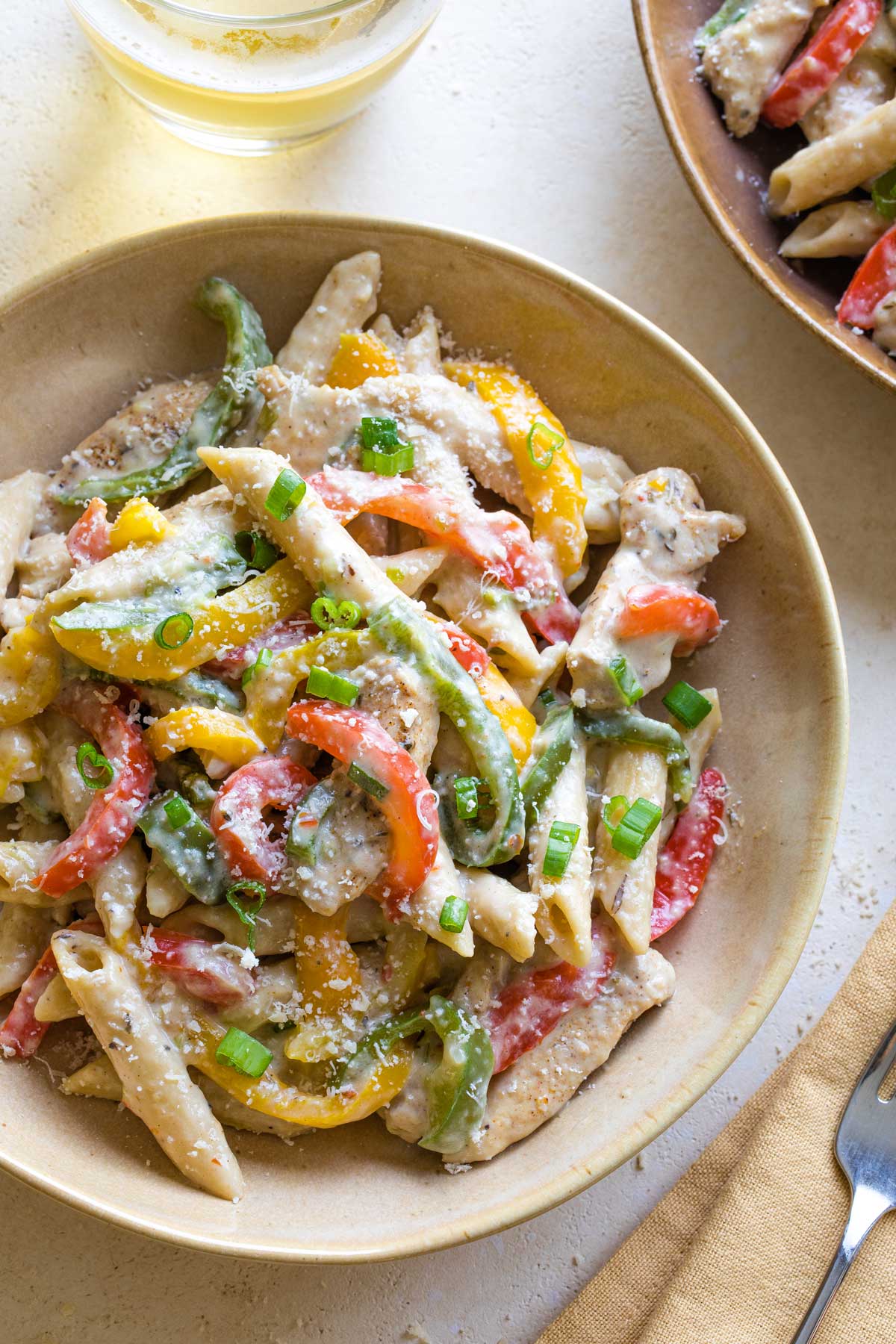
There’s a reason that Rasta Pasta is sweeping the globe, and has even inspired an award-winning Colorado restaurant featured on Food Network.
This stuff is GOOD. And addictive. It’s edgy yet comforting … calm and creamy, yet punchy and zingy.
Ingenious and awesome.
But Exactly What IS Rasta Pasta?
Basically, it’s the delicious crossroads where spicy Jamaican jerk chicken and veggies meet up with a cozy bowl of creamy, alfredo-y pasta.
Variations and unique interpretations abound. Some sauces are less alfredo-creamy, and some versions use coconut milk or swap out the chicken for another protein like shrimp, or even a vegetarian option.
But overall, our interpretation here is fairly typical in terms of flavors. (With some easy, nutritious upgrades, of course)! We’re talkin’ …
- Perfectly al dente pasta
- Red, yellow and green peppers (which mirror the vivid colors in the Rastafari flag)
- Tender, juicy Jamaican jerk chicken strips
- All scrumptiously bathed in a lightly jerk-spiced cream sauce
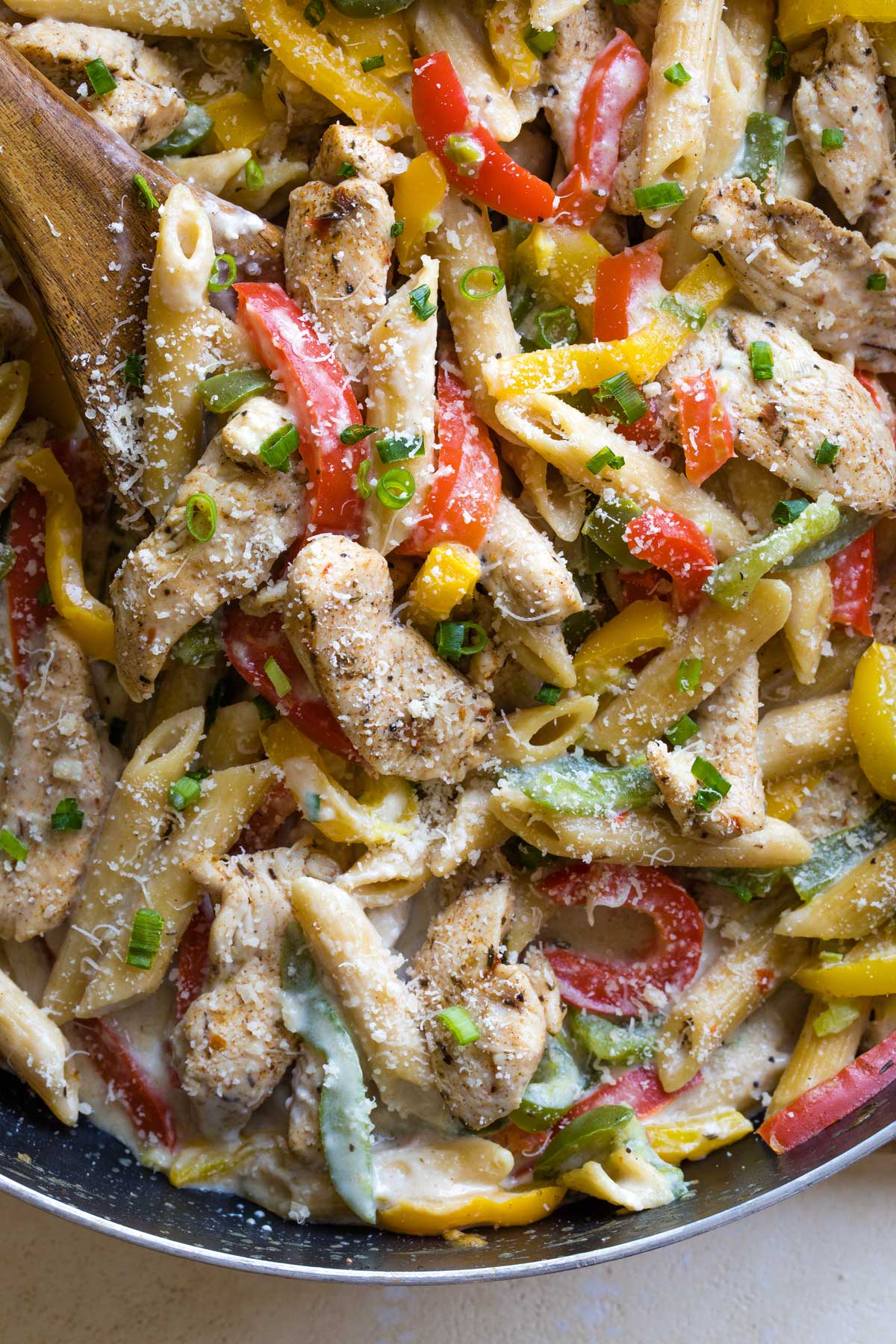
Ahhhh yes … now you see what I mean by ingenious. This stuff is just alllll kinds of fantastic!
So, Does Rasta Pasta Actually Come From Jamaica?
Rasta Pasta really can trace its origin back to Jamaica.
Local Jamaican lore steadfastly attributes its creation to Chef Lorraine Washington in the town of Negril, on the island’s scenic western coast.
One Jamaican newspaper, The Gleaner, explains that Chef Wahington put together the pasta dish to feed hungry construction workers at Negril’s Paradise Yard Restaurant, back in 1985.
As the legend goes … the recipe’s vibrant green, yellow and red colors prompted one of the workers to christen Washington’s creation “Rasta Pasta” in a nod to the Rastafari flag. And, since Washington first made her soon-to-be-famous dish with fettuccine (instead of the now-common penne), those enthusiastic diners ran with the rasta theme even further … pointing out that the strings of pasta looked like Rastafari dreadlocks!
The bottom line: Chef Washington’s inventive Jamaican pasta recipe was one great big HIT. Washington put it on her restaurant menu, and a new foodie obsession was born!
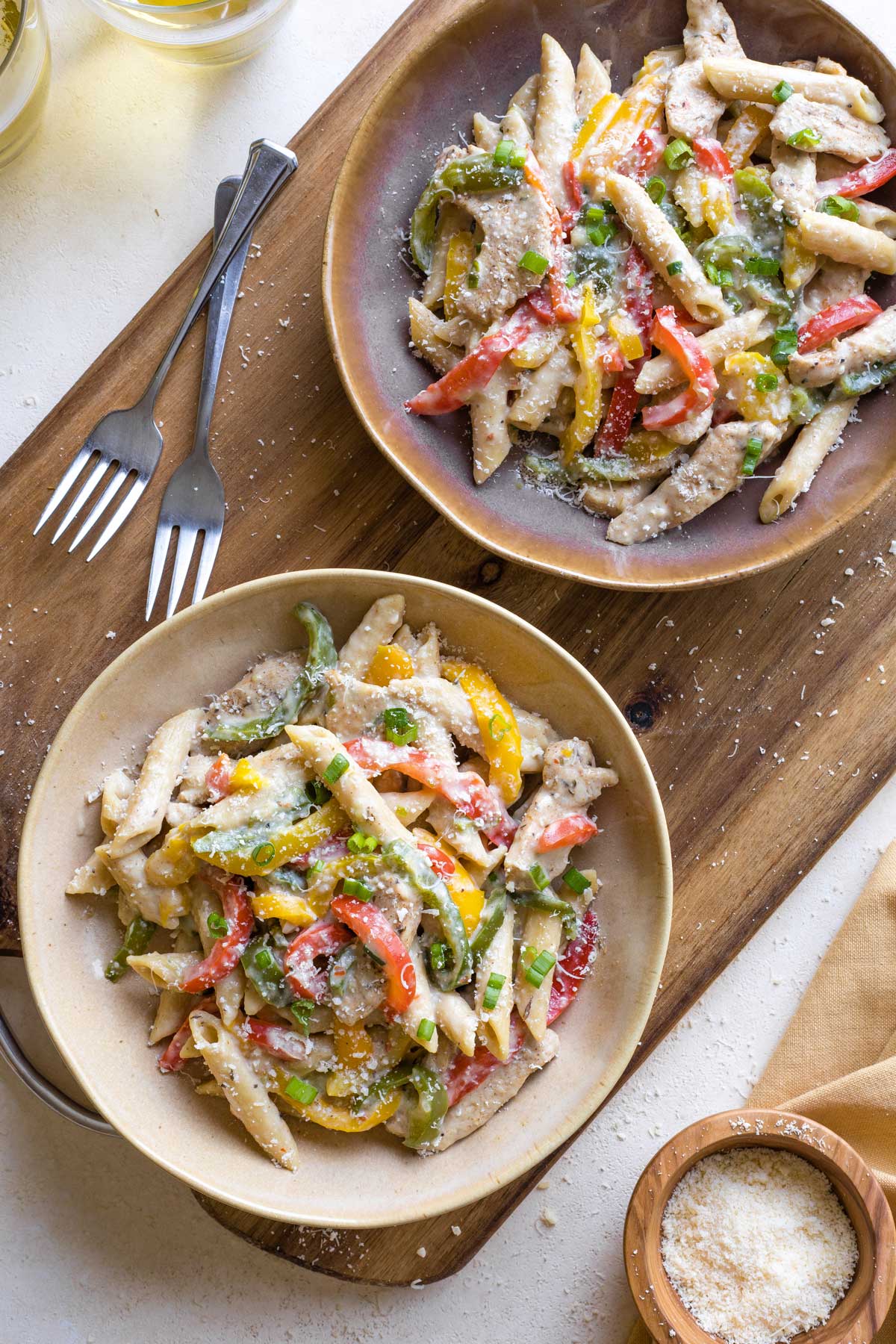
Why Our Version Is the One That’ll Steal Your Heart
With so many different variations of Jamaican Rasta Pasta for you to try, why is this THE ONE? Glad you asked!
✔ Just One Pot, Friends!
Other recipes out there involve multiple cooking processes … like separately cooking the pasta, roasting or sauteeing the veggies, and cooking the jerk chicken. (I’ve seen one Rasta Pasta recipe with 15 steps. WHOA!)
That just feels like a lot of separate pots, pans, and cooking methods happening, in order to pull a supposedly “quick” dinner together. Lots of dishes to wash. Lots of things to coordinate at the hectic dinner hour (when you’re probably helping with homework or simultaneously doing laundry or paying bills … or … or … or … all.the.things …).
I’m a devoted, raving fan when it comes to one-pot pasta recipes. So darn easy!
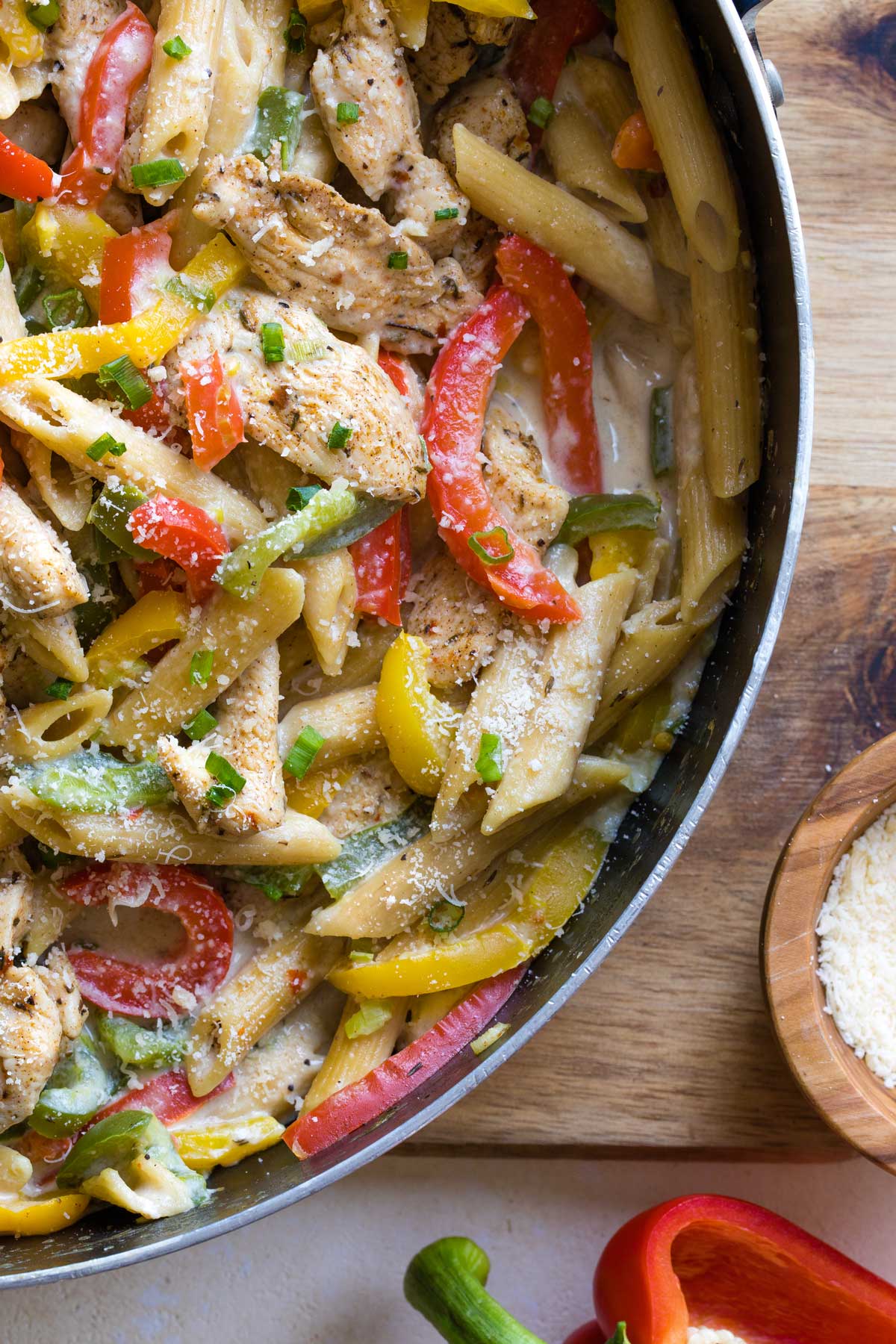
(Pssssst … if you’re in the fan club, too, definitely also check out my recipes for One-Pot Creamy Cajun Shrimp Pasta and for One-Pot Whole-Wheat Pasta with Asparagus, Peas and Parmesan, or even our “almost-pasta” recipe for Cheesy BLT Pierogi Skillet!)
✔ And It’s Healthier, Too!
Lots of other Rasta Pasta recipes automatically reach for heavy cream – maybe 3/4 cup or more – in order to create that velvety, spiced alfredo sauce.
But as the Kitchn explains, the one-pot cooking method brilliantly creates a base for creamy sauces, since it retains the starch that the pasta releases during cooking. The starch in your pasta water acts as a thickener and a binding agent. It’s the perfect building block for a cream sauce … without the typical, naughty calories and fats!
Some nonfat milk and just a dab of reduced-fat cream cheese are all you need to elevate the cooking liquid to a velvety, alfredo-esque sauce mixture. (Plus, we stir in the common Rasta Pasta ingredient of parmesan cheese.)
So, yeah. There’s A LOT to love here!!
Now let’s get to the action … and actually make this glorious concoction …
How to Make This Easy Rasta Pasta Recipe
Ingredient Prep
There isn’t much prep work to be done (yay … easy!) – mostly just slicing up some veggies and chicken.
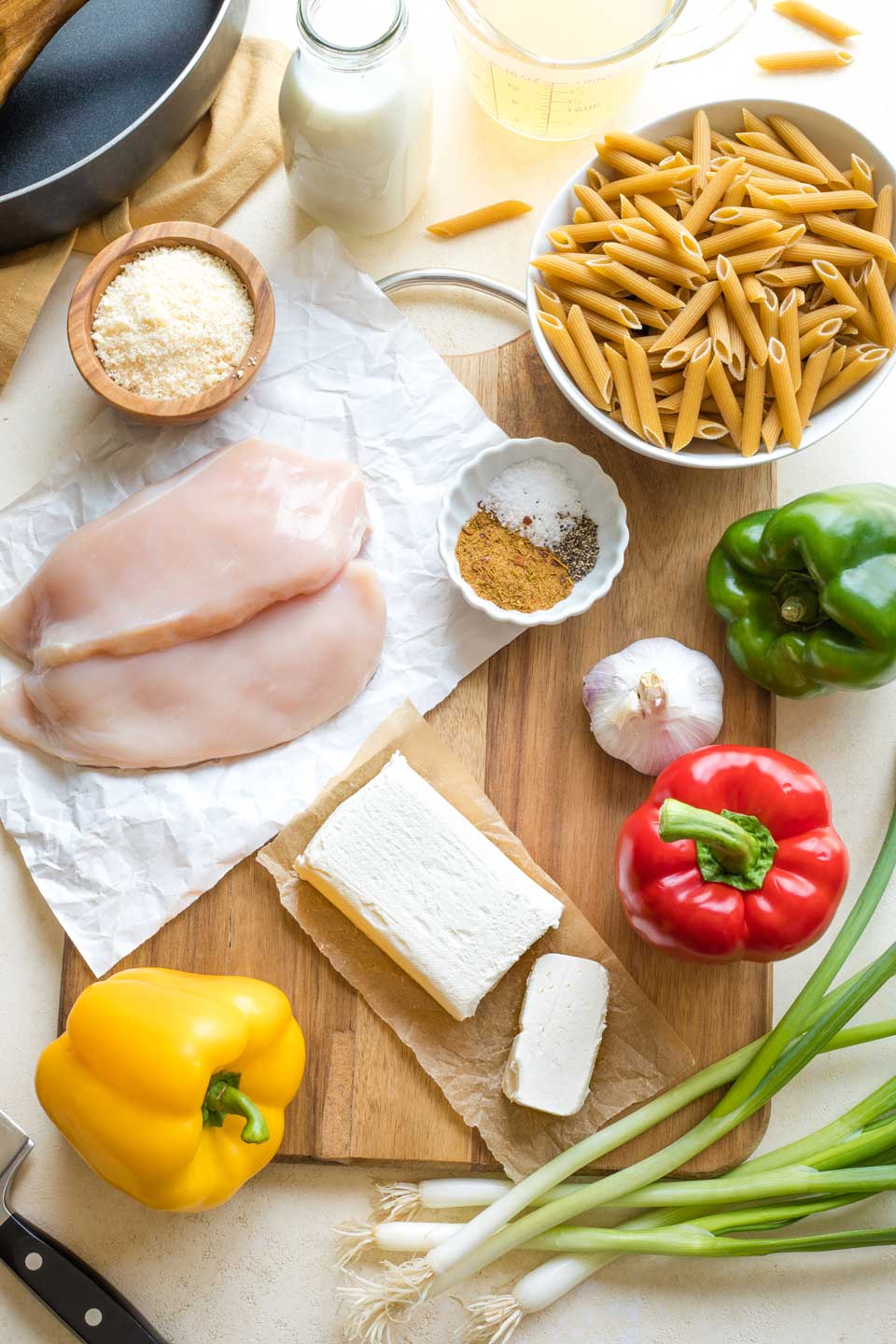
But, here’s the important thing: Some of the cooking steps of this recipe happen pretty quickly, so you’ll want to have all your ingredients prepped, measured and ready, before you fire up your stove to start cooking. (This is known as mise en place.)
Ingredient Tip: Pepper Colors
You’ll notice that I call for three different colors of bell peppers: red, green and yellow.
Again, that’s because those colors are a nod to the Rastafarian culture in Jamaica. So, as I mentioned before, that particular combination of colorful bell peppers is what gave this recipe its name. And, of course, the medley of three different colors is really pretty!
But, you can certainly go with the pepper colors you prefer, or whichever ones happen to be on sale at the market.
As you’re cutting your peppers, think of fajita-size, thin slices.
Similarly, for the chicken breasts, you want bite-sized strips about 1/2-inch thick and 3 inches long.

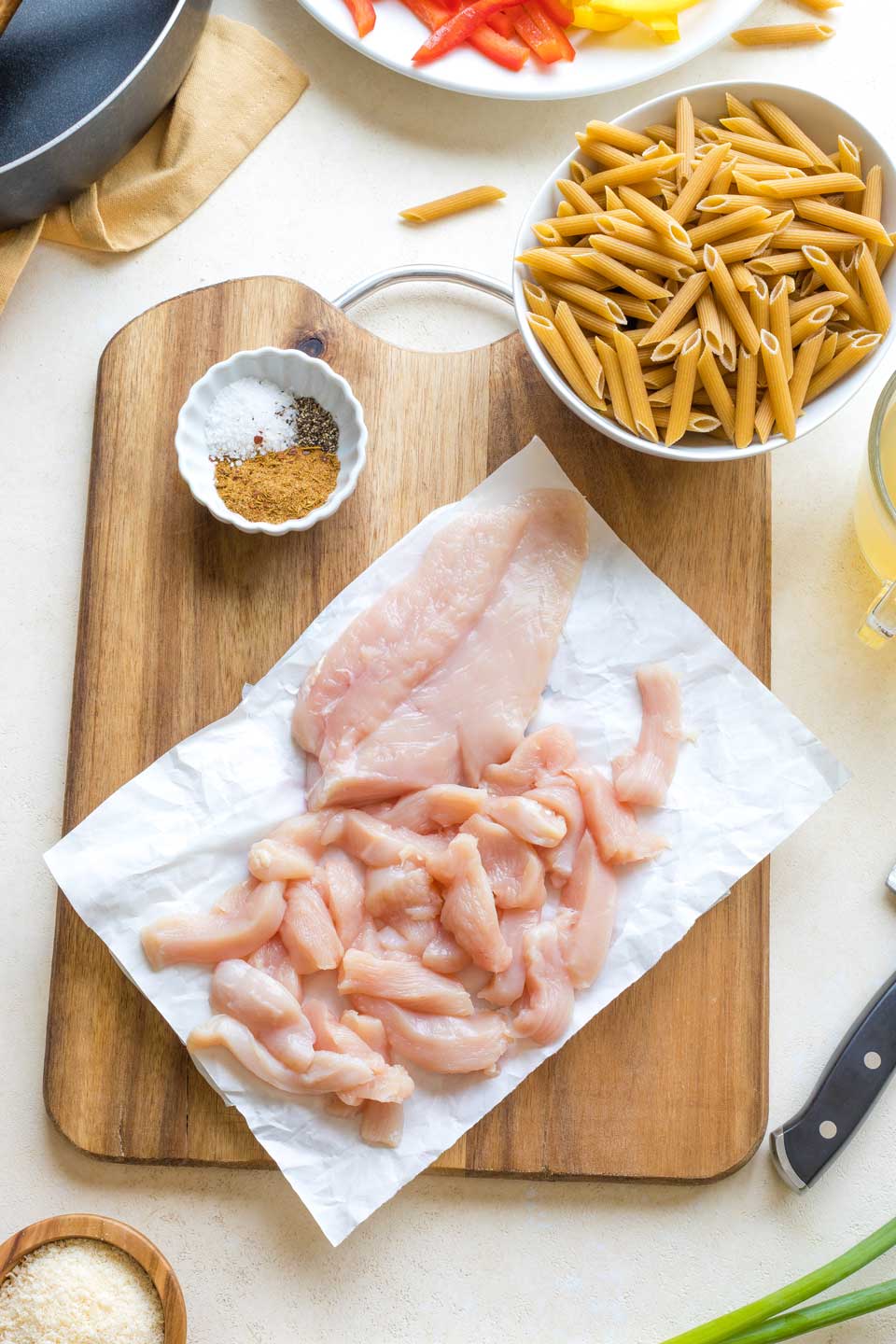
Prep-Ahead Tip
It’s easy to get your main ingredients ready in advance. You can cut your peppers, green onions, garlic and chicken breasts up to a day ahead. Refrigerate them separately (each in an airtight container) until you want to start cooking.
Once you’ve got all your ingredients ready, it’s time to bring this delicious dinner together!
Step #1
The first layer of Rasta flavors happens with the chicken.
You evenly sprinkle your chicken with 2 teaspoons of the Jamaican jerk seasoning, 1/4 teaspoon of salt, and 1/8 teaspoon of pepper.
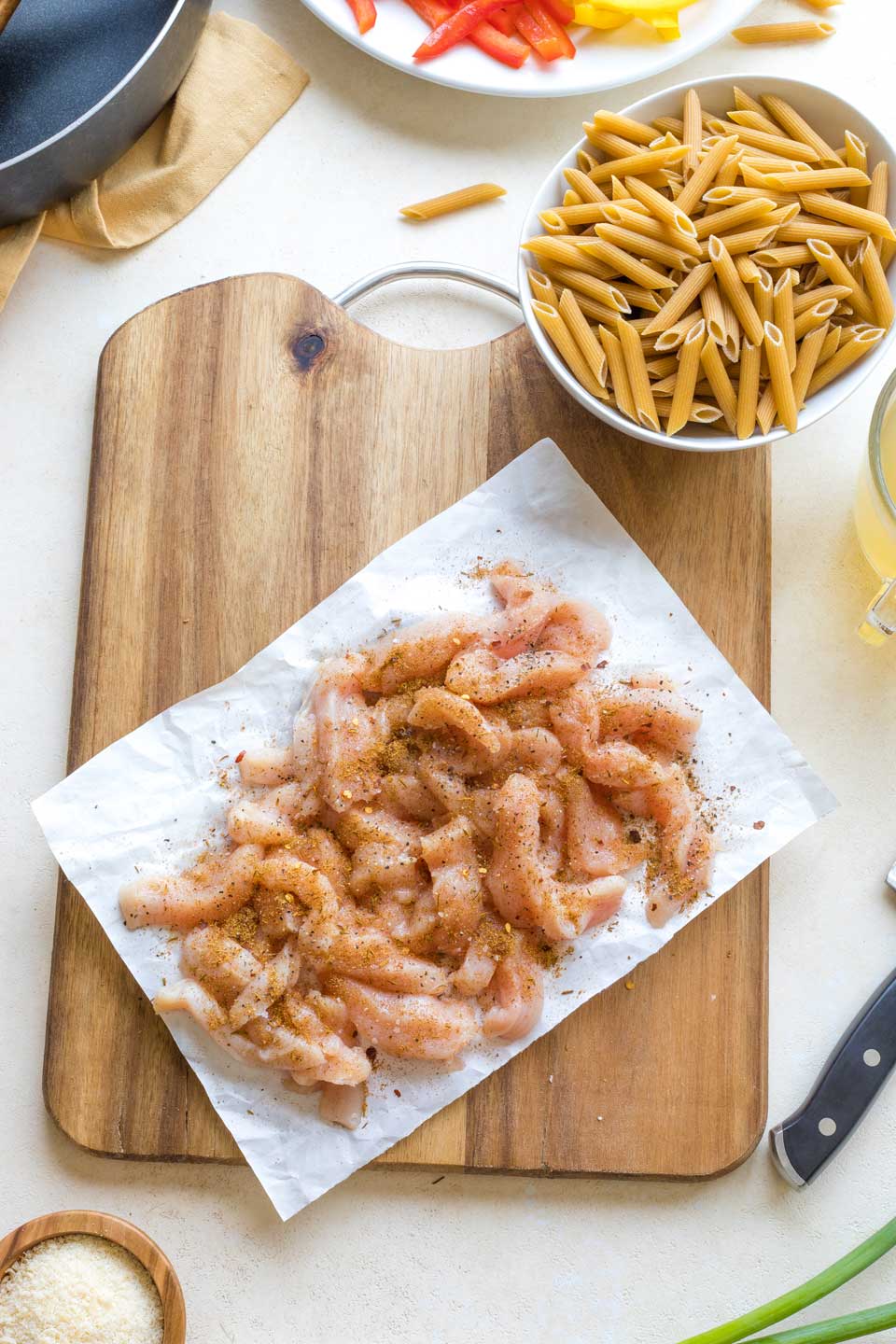
NOTE that this is NOT all of the seasonings. You’re reserving some of the seasonings to add a second layer of jerk flavors to the pasta in Step #3!
Give the chicken a toss so that the strips are coated thoroughly and evenly with the spice mixture.
Step #2
Heat a tablespoon of oil in a nonstick, large skillet over medium-high heat.
Add the chicken strips to your pan, giving them a frequent stir so they cook evenly.
You want to cook your chicken until it’s just barely done (which should take about 4 minutes).
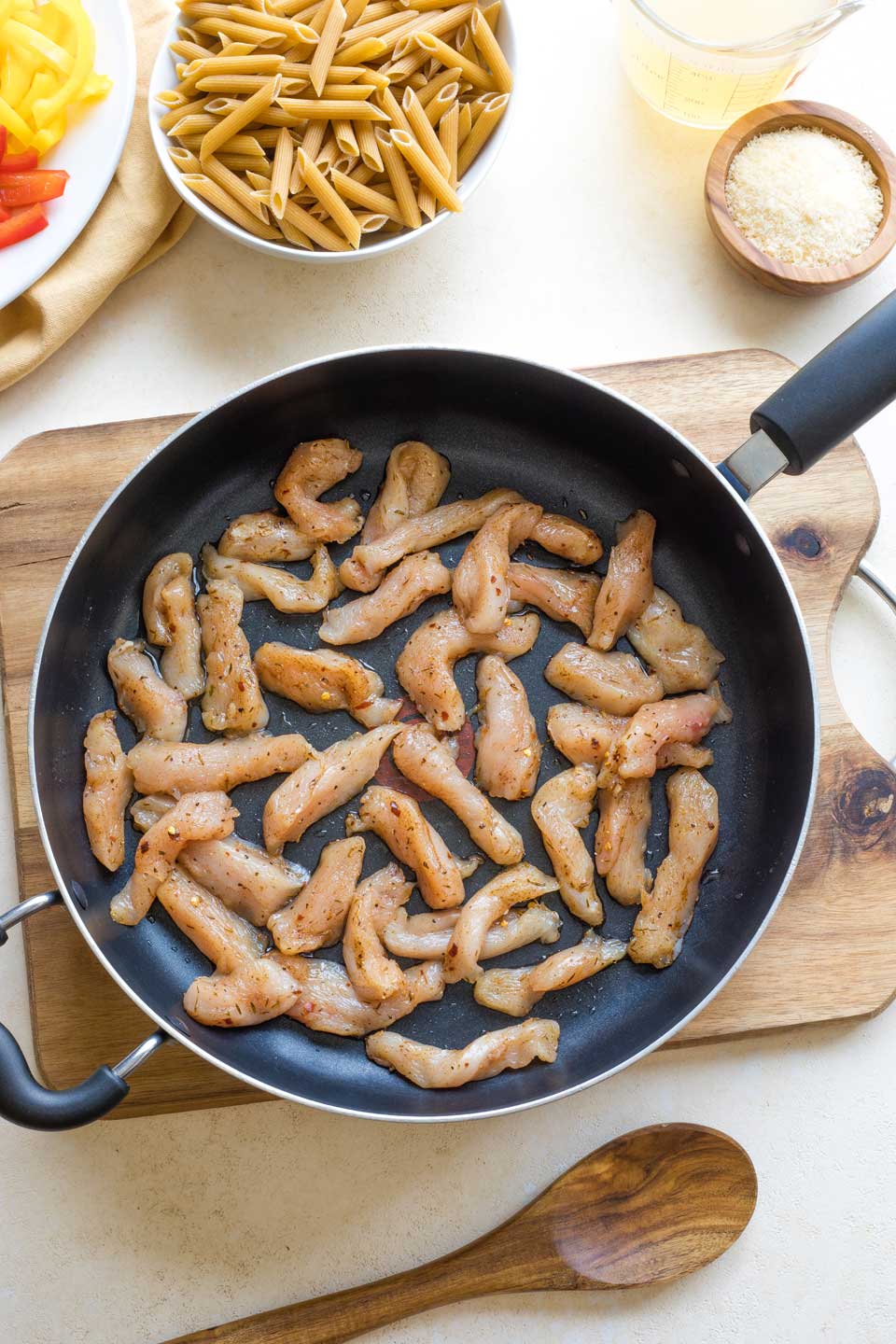
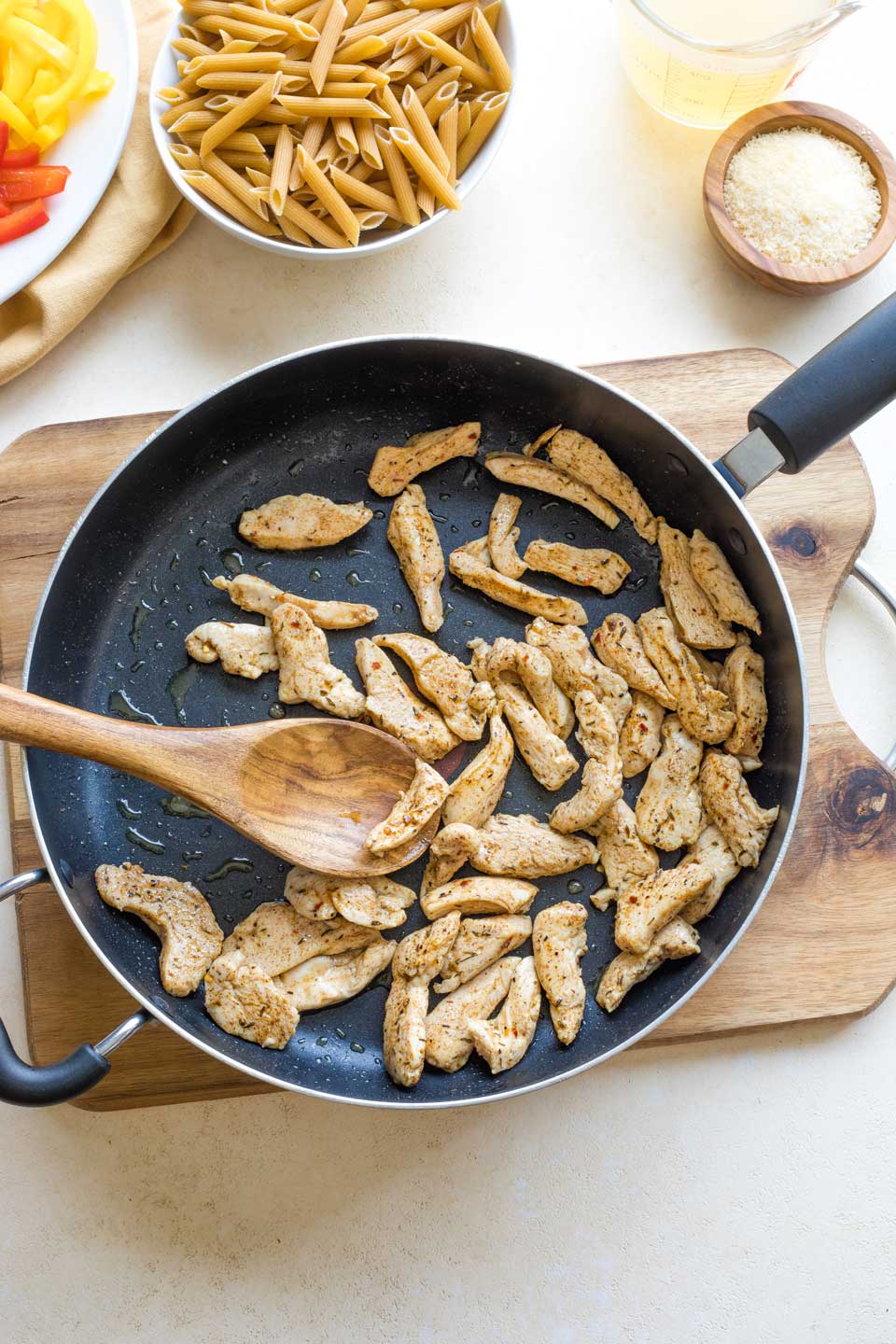
The key here is “just barely done.”
The chicken strips will continue to cook a little through residual heat while they’re covered and set aside, as you’re cooking the pasta. And they’ll also cook a bit further when you add them back into the pasta pan to finish the dish.
So right now, you want them to be just done or even very slightly under-done. That way, they’ll be perfectly tender and not overcooked when you serve the final dish.
Scoop your perfectly cooked chicken out of the skillet and keep it warm, off to the side. A plate that’s lightly covered with foil works great.
Step #3
Next, add your pasta to the skillet and top it with your pepper strips, green onions and garlic.
It’s important that the pasta goes in first, so it’s submerged under the veggies.
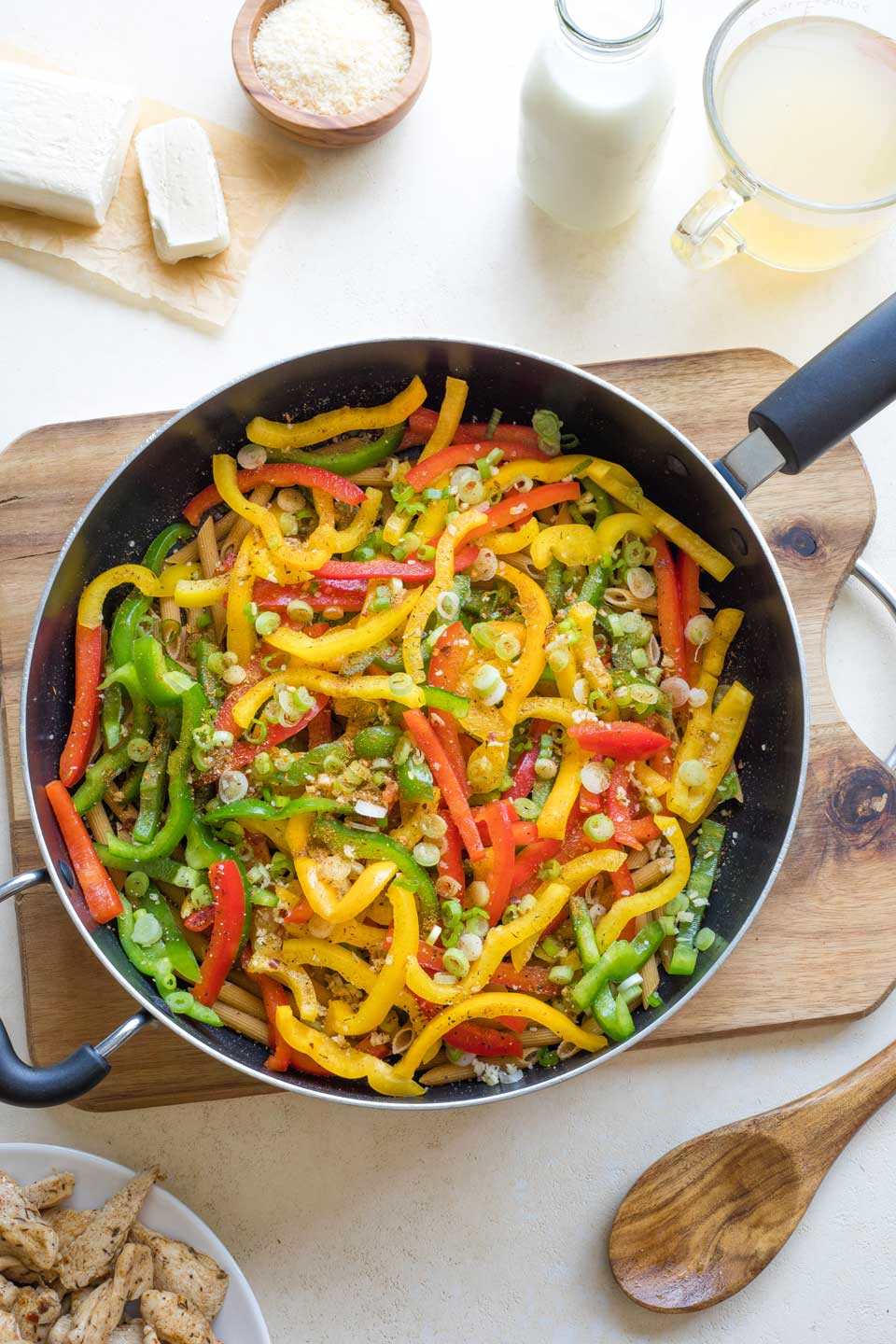
Now, remember the extra jerk seasoning, salt, and pepper you had left over, after you seasoned your chicken? This is where the extra seasonings come in, so you’re layering Jamaican jerk flavors all through the dish. (Yum!) Sprinkle them evenly over top of your pasta and veggies.
Then pour the chicken broth and milk into the skillet.
Stir everything just slightly, to combine it all a little bit and separate the pieces of pasta. BUT try really hard to keep the pasta at the bottom, submerged in the liquids. That’s key to getting properly cooked pasta in a one-pot pasta recipe like this one.
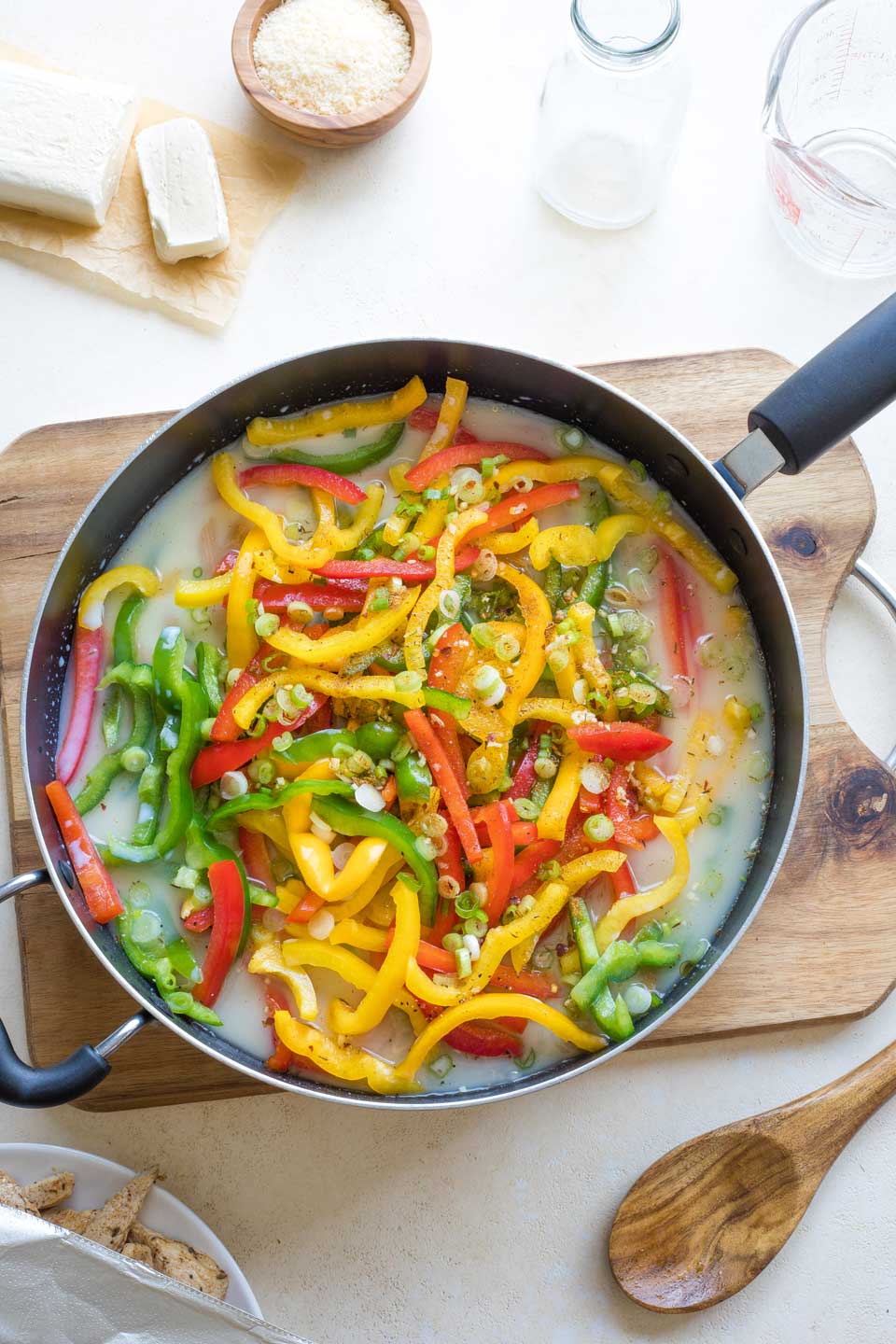
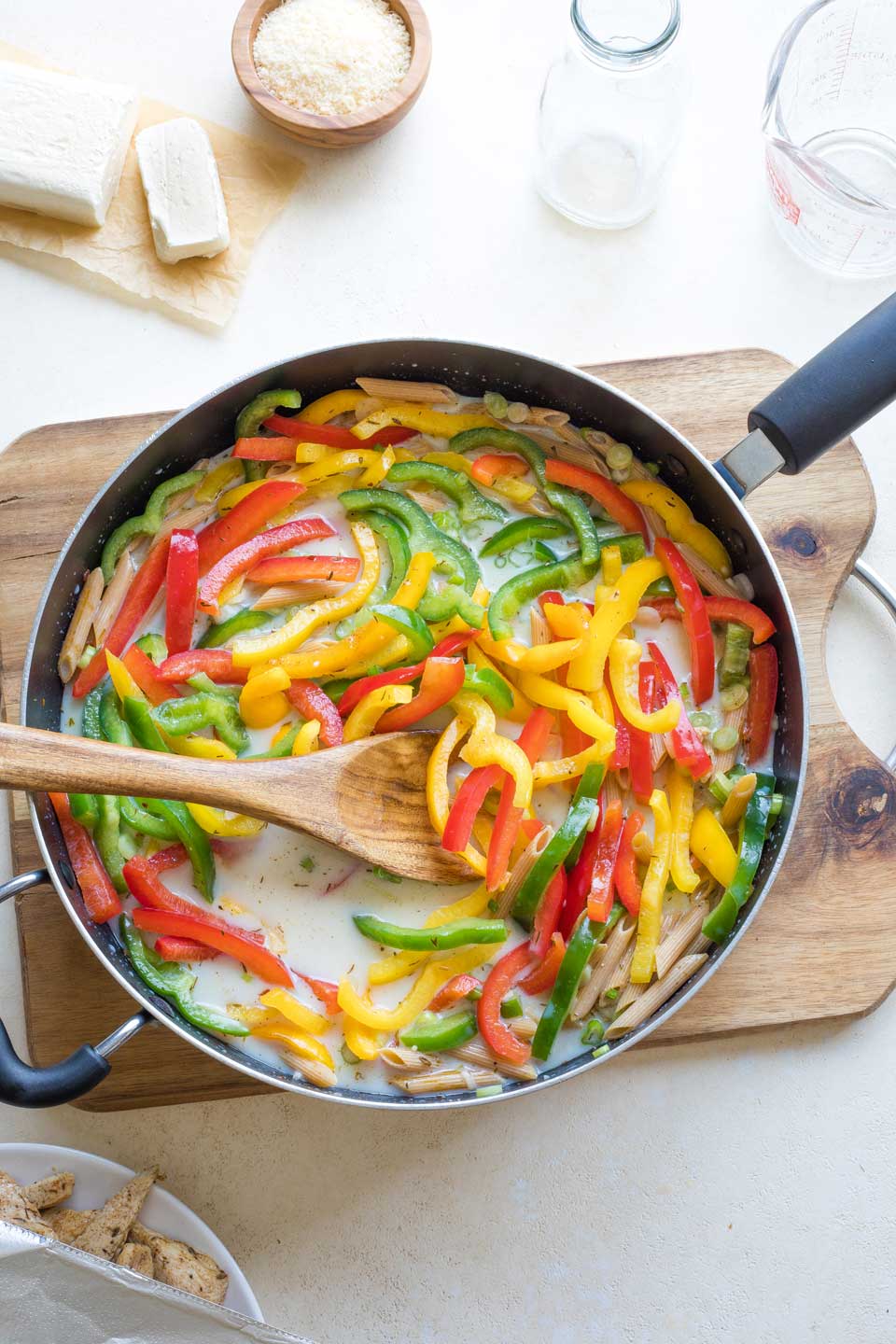
Cover the skillet and turn up the heat to bring your Rasta-inspired pot of deliciousness to a boil (this usually takes about 5-7 minutes on my stove).
Step #4
Once you’ve got it boiling, reduce the heat back down to about a medium-low or medium heat. You want to maintain a lively simmer, but NOT a hard, full, rolling boil.
Take a peek at your creation every so often, to be sure it’s not boiling too fiercely, and adjust the heat if you need to.
And, every so often, give it all a stir, remembering to keep the pasta as submerged as possible, with the veggies mostly on top.
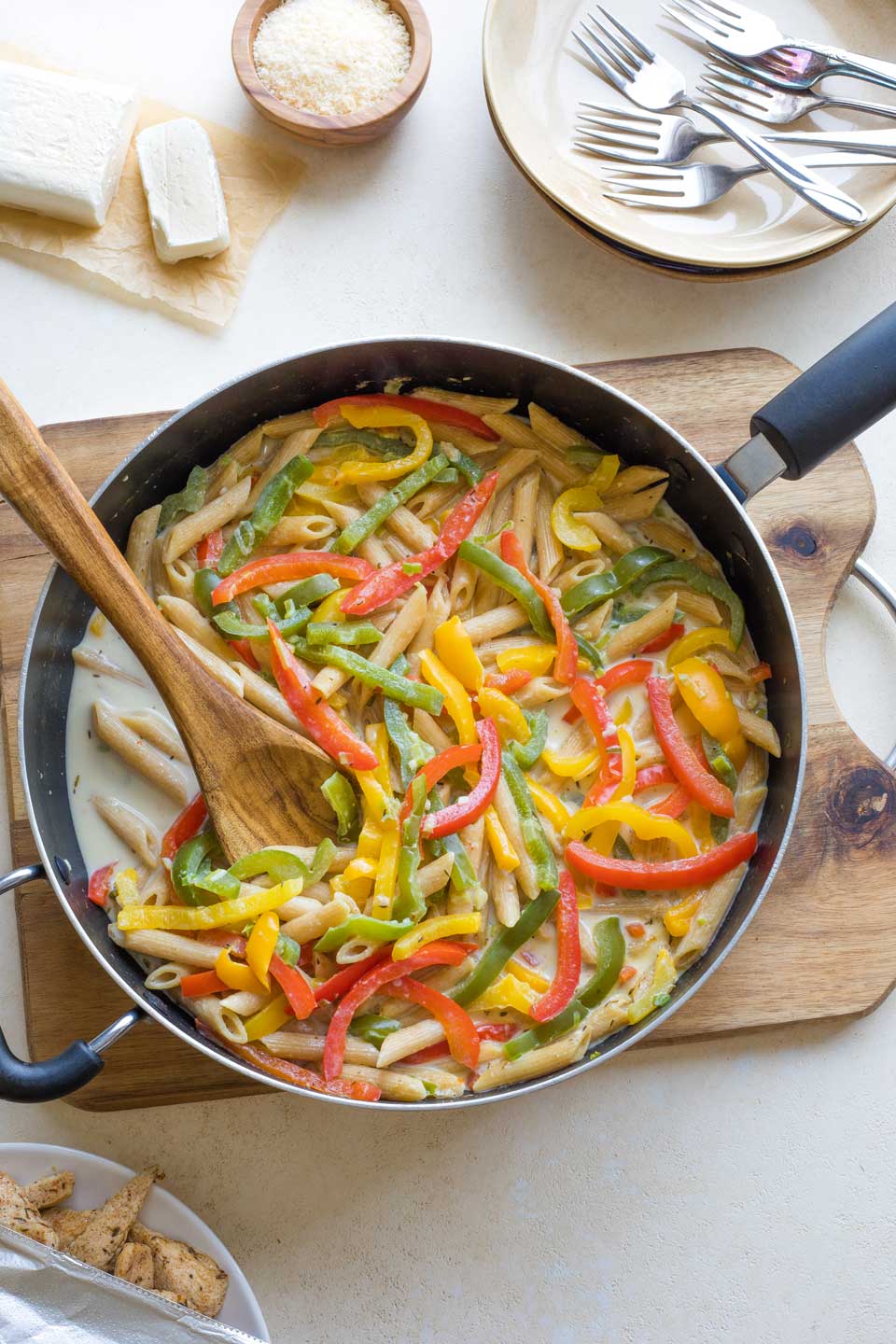
The precise cook time depends on your brand of pasta. But for perfectly al dente penne, you’re looking at about 13-14 minutes (for whole-wheat pastas).
Step #5
Mmmmmmm … now we get into the creamy, alfredo-y, cheese-y stage. YES! This is where it really gets good!
Just a little cheesiness goes a long way, without piling on too many extra calories or too much unwanted saturated fat. No heavy cream (or even half-and-half) needed at all!
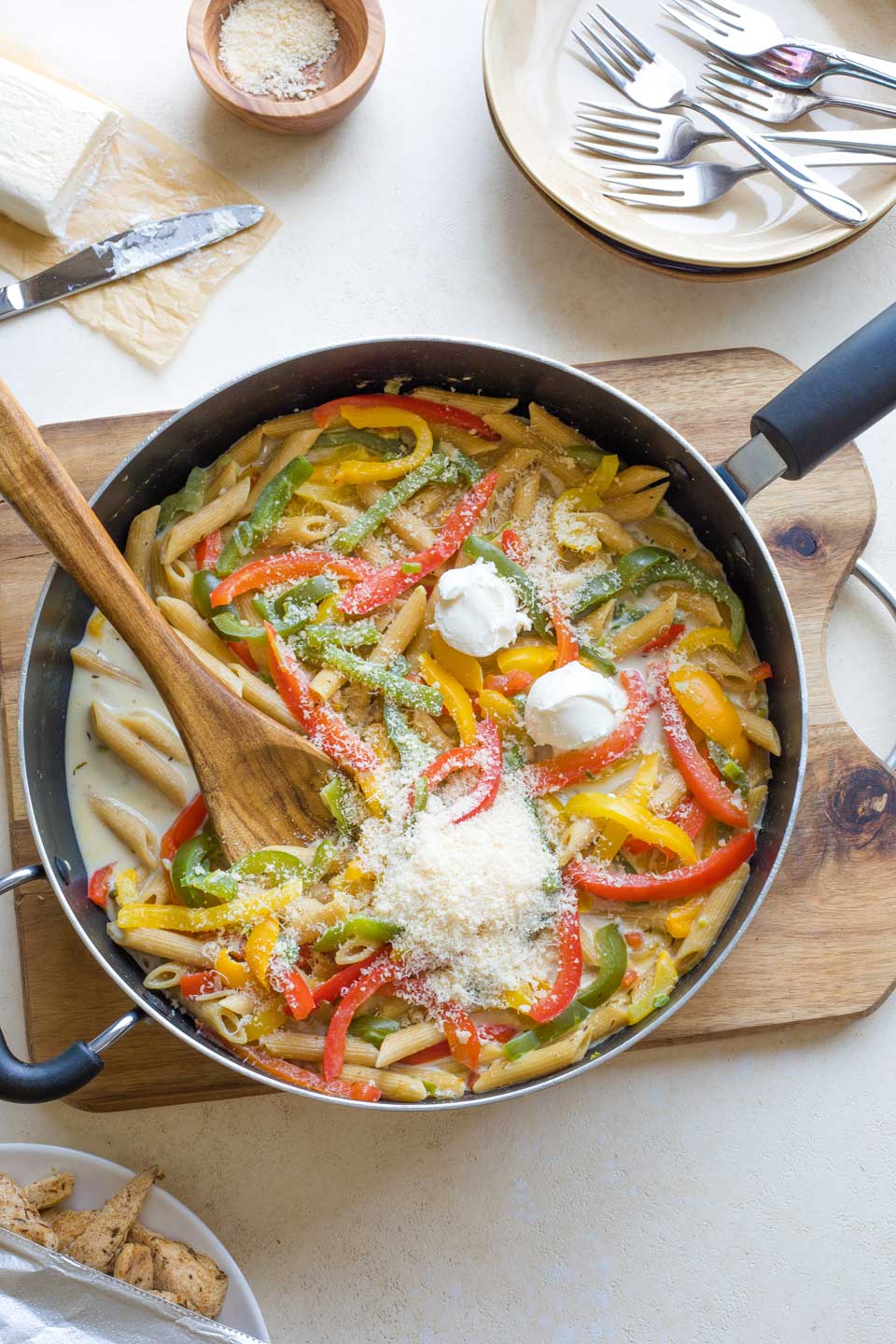
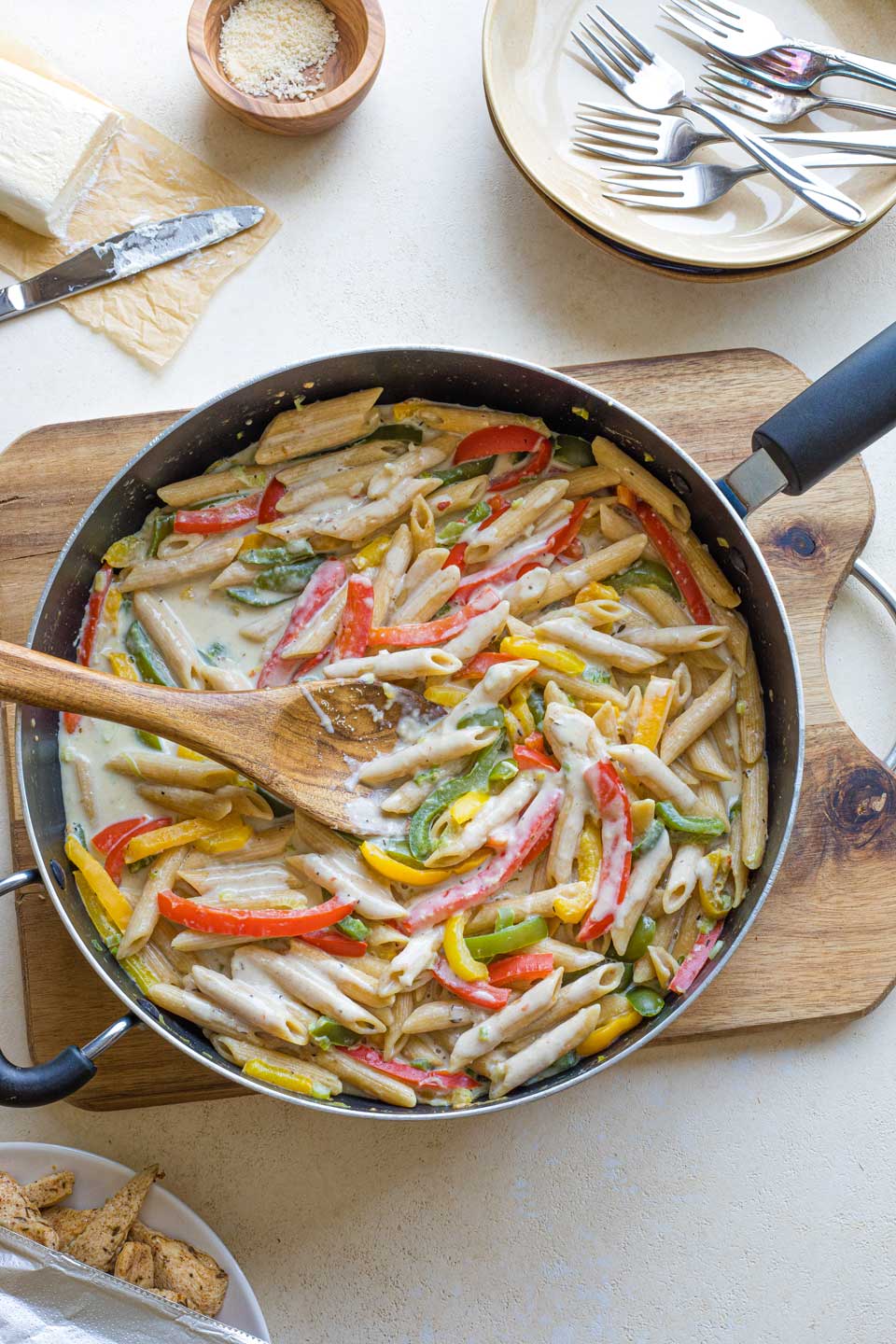
Stir in your parmesan cheese and just 2 tablespoons of the cream cheese until the cream cheese is melted and it’s all melded into a smooth sauce.
How Creamy Do You Want Your Sauce?
You can add one more tablespoon of cream cheese now, if you want to. But I recommend waiting to taste at the end before you decide if you even need that additional dollop of cheesiness.
My taste-testers couldn’t agree on whether they preferred this dish with 2 or with 3 tablespoons of cream cheese … so the choice is totally yours!
Step #6
Stir your chicken (plus any juices that have accumulated on the plate) back into the skillet full of pasta and veggies.
Cook it just briefly, only until the chicken is re-warmed and fully cooked.
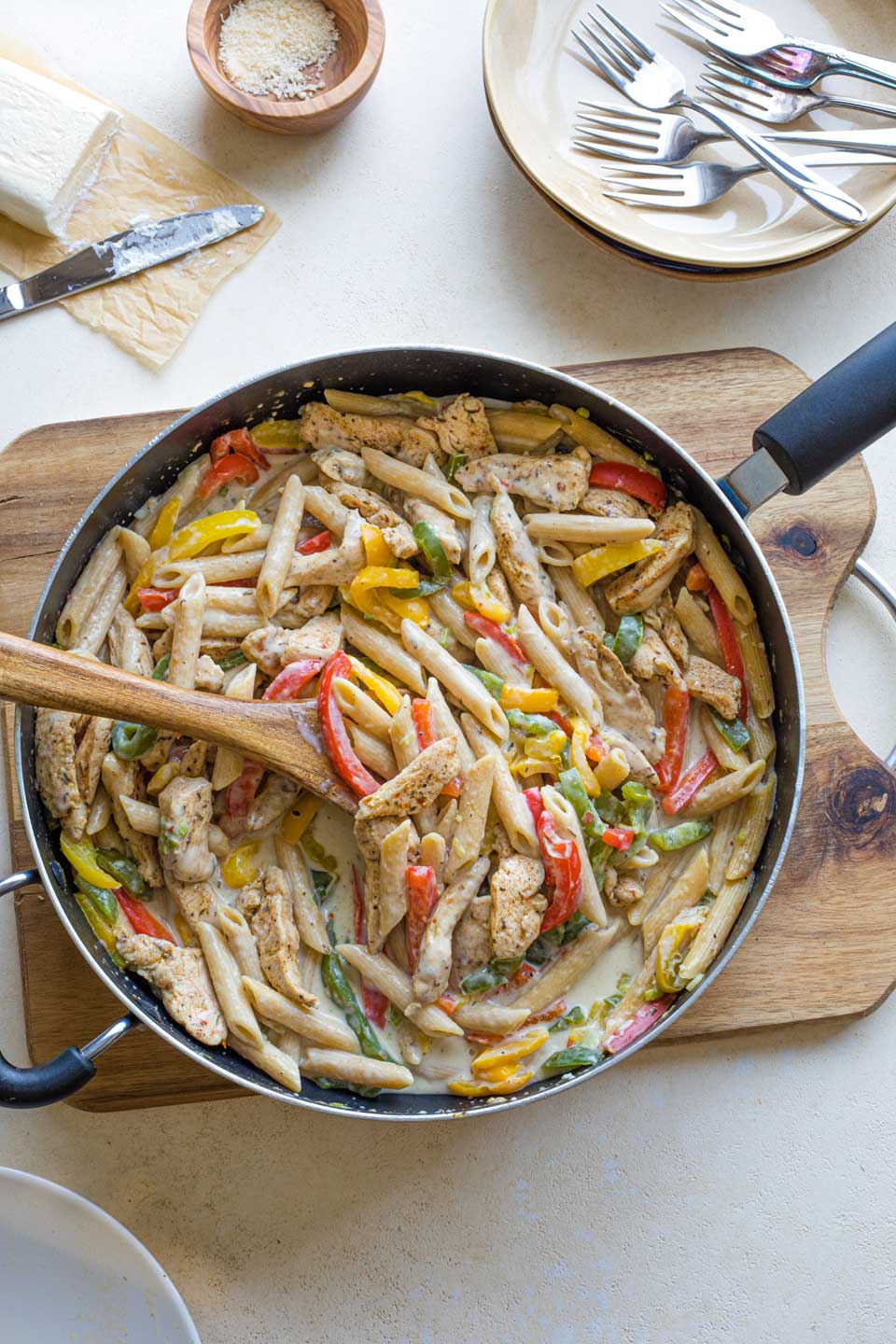
Your Rasta Pasta will continue to thicken a bit upon standing, so it’s ok at this point if it still seems a tad runnier than you’re shooting for.
Also, before you take your skillet off the heat, it’s the perfect time to give your dinner a taste, so you can adjust it exactly the way you like.
Adjusting the Flavors and Spiciness of This Jamaican Jerk Chicken Pasta
It’s easy to tweak this Rasta Pasta recipe so the flavors are precisely what you and your own family prefer, whether that’s more boldly spicy … or more mild, rich and creamy.
Here are some tips:
• Tip 1: Spice It Up
You can definitely add more jerk seasoning if you’d like your Rasta Pasta to be kickier, with more of a bold Jamaican spin on your creamy pasta dish.
I’ve written the basic recipe so it has the signature kick you’d expect from a jerk chicken dish, but isn’t TOO spicy – and should be acceptable to most families and tastes.
But you can definitely dial up the heat!
In fact, we’ve actually used as much as 2 tablespoons of jerk seasoning for a nice kick – so there’s a lot of room for you to vary the heat here.
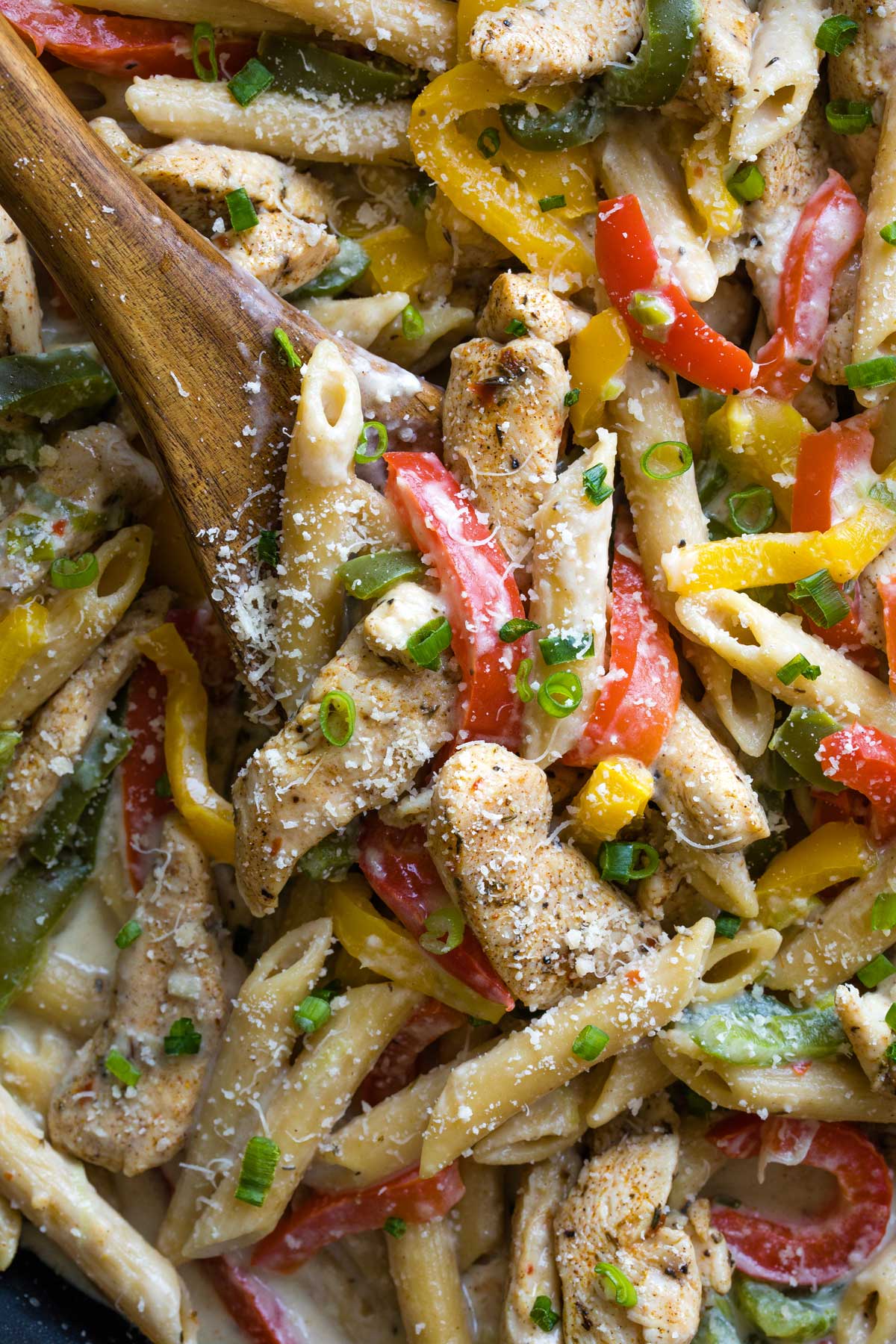
Alternately, if your family can’t all agree on how much kick they like, you can simply pass the bottle of jerk seasoning ’round the table, and let each person customize their own.
• Tip 2: Adjust the Salt
You may also need to add a pinch of salt, since various brands of jerk seasoning have different amounts of salt in them.
This recipe was extensively tested with McCormick’s Perfect Pinch Caribbean Jerk Seasoning, since I figure McCormick spices are fairly accessible to most American grocery shoppers.
• Tip 3: Make It Creamier
Lastly, if you stirred in just 2 tablespoons of cream cheese earlier in the recipe, now’s when you can opt to add one more tablespoon (for 3 tablespoons total).
Adding the third tablespoon will make your Rasta Pasta a bit more creamy and alfredo-y. And, it slightly softens and mutes the heat level, if you find that the jerk seasoning is actually too punchy for you.
How to Serve Your Rasta Pasta
Garnishes
I like to sprinkle an extra cascade of parmesan on top of my skillet meal, and toss on some sliced green onions for a nice pop of color.
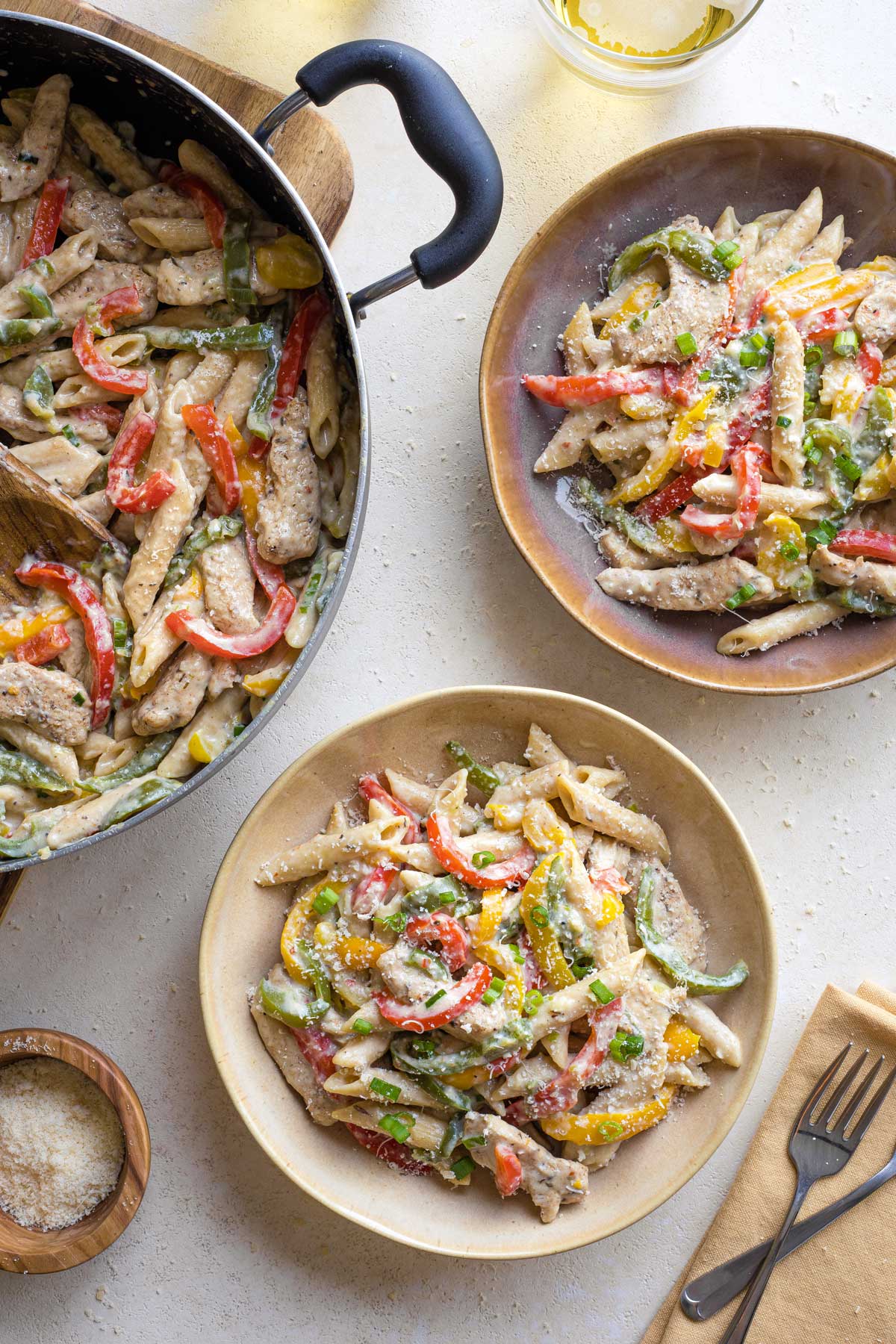
But that’s totally optional, and your Rasta Pasta will be 100% delicious and awesome if you skip the garnishes and just dive straight on in there!
Side Dish Ideas
This one-pot skillet dinner is really a complete meal, all in one easy pan. You’ve got protein, whole grains and lots of veggies … you really don’t need anything else if it’s a busy night and you wanna keep things simple.
But, if you’d like to set out a couple extra sides, I’d recommend:
- a crisp green salad
- a vibrant mix of other veggies that won’t compete with the jerk flavors in your pasta
- or a refreshing fruit salad to serve as a sweet counterpoint.
Try one of these delicious ideas …
FAQs At-a-Glance
Sure! Rasta Pasta recipes in the US commonly feature penne, but as I mentioned above, the original Rasta Pasta allegedly used fettuccine. You can experiment with different shapes like fusilli, rigatoni, or even spaghetti. But, you’ll likely need to adjust the cooking time (use the package instructions as a guide), and possibly slightly tweak the amount of cooking liquid.
This is a trickier substitution than simply swapping pasta shapes. Like I discussed earlier in this article, a key to what makes one-pot pastas like this work so well is that wheat pastas release a certain amount of starch during cooking. That starch acts as a thickening agent to help create a silky, creamy sauce for this recipe. But, depending on what they’re made of, various types of gluten-free pasta can actually contain even MORE starch. I haven’t tested the full range of different gluten-free pasta options, and can’t vouch for how you may need to adjust this recipe (and specifically the amounts of liquids) when subbing gluten-free pasta.
Yep – you sure can! It performs well if you gently rewarm it on fairly low heat (on the stovetop or even in the microwave), so the chicken doesn’t overcook and get tough. It’s a great recipe for when you want to make dinner earlier in the day (when you know you’re headed for a hectic weeknight and the dinner hour is gonna be craaaaaa-zy). Or if you love meal prepping and having terrific leftovers all week long!
Definitely! I go into more detail in the article above, but the short answer is YES … you can adjust the amount of jerk Caribbean seasonings you use. In our testing, we settled on the amount written in the recipe card (3 1/2 teaspoons) as a fairly reasonable heat level most families would enjoy. But my family has made this recipe with as much as 2 tablespoons for a much more spicy Rasta Pasta. Note that the formulations (and spiciness) of different brands of jerk seasoning vary (we use McCormick). Alternately, if you find that your pasta is too spicy when it’s done cooking, try adding an extra tablespoon of cream cheese, which softens the Jamaican flavors and tones down the heat.
Sure thing! As directed in the detailed instructions on the recipe card below, I recommend making the recipe with 2 tablespoons of cream cheese. Then, right before you take the finished meal off the stove, taste it to make adjustments – including making it creamier, by adding an extra tablespoon of cream cheese, if you’d like.
Now, there’s no need to book a trip to Jamaica, just to find yourself some amazing Rasta Pasta. (Although, hey, I’m sure not gonna stop you if you can make a Jamaican getaway happen!)
For sure … this recipe is about the easiest way to get some creamy jerk chicken pasta in your life ASAP.
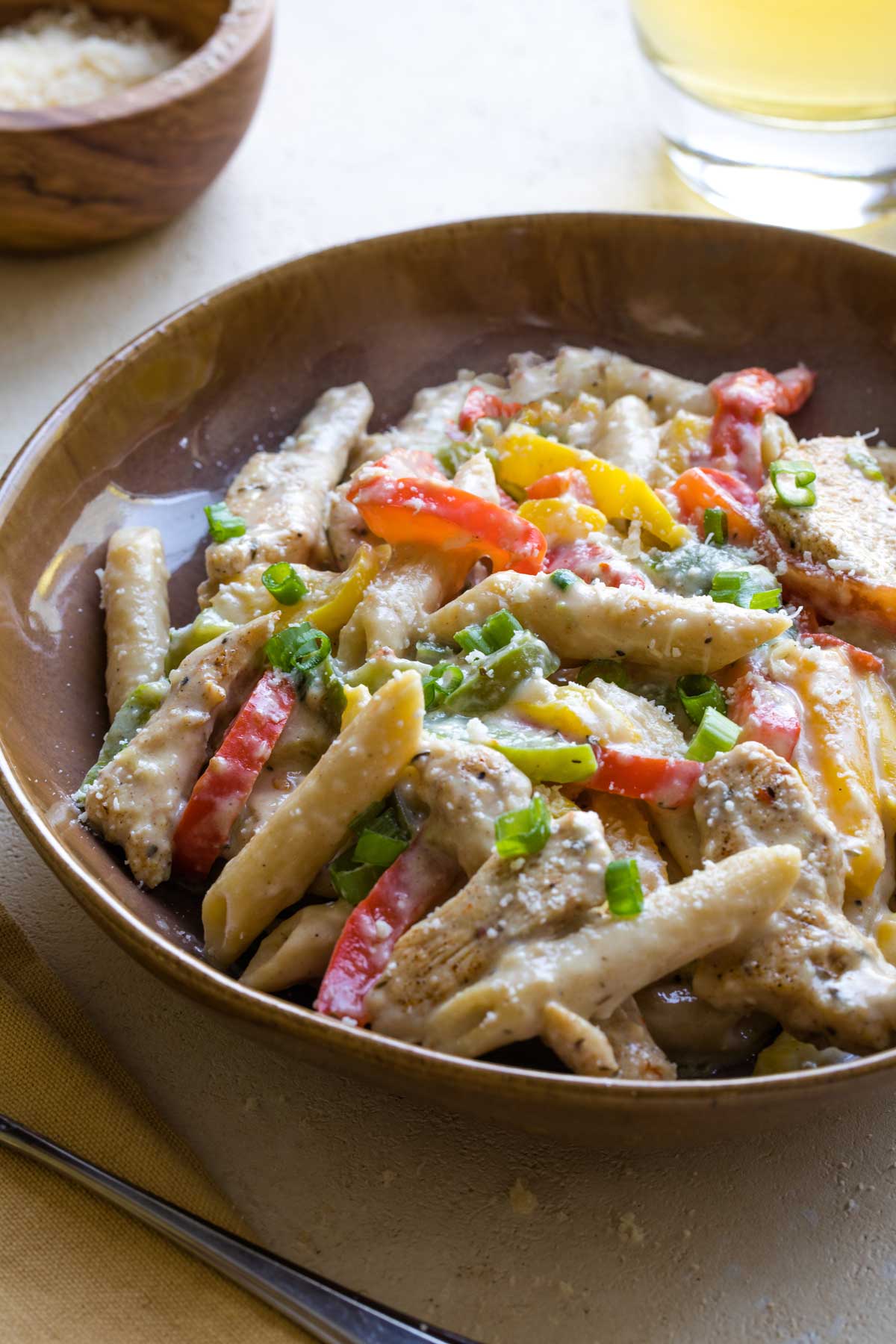
With just one pot and such an improved nutritional profile, this recipe has everything that makes Rasta Pasta an enduring fan favorite. Plus, everything that’ll make you feel terrific about making it at home, for your own family, too!

~ by Shelley
Love the Recipe? • Were My Tips Helpful?
__________
Please leave a 5-star rating by clicking on the stars in the recipe card below. I truly appreciate all your wonderful feedback!

Rasta Pasta Recipe (One Pot!)
Ingredients
- 1 pound boneless, skinless chicken breasts, cut into thin strips about 3" long x ½" thick
- 3½ teaspoons jerk seasoning, divided (see note)
- 1¼ teaspoons kosher salt, divided
- ¼ teaspoon black pepper, divided
- 1 tablespoon olive oil
- 8 ounces penne pasta (preferably whole wheat)
- 1 medium green pepper, thinly sliced (to equal about 1½ cups)
- 1 medium red pepper, thinly sliced (to equal about 1½ cups)
- 1 medium yellow pepper, thinly sliced (to equal about 1½ cups)
- ⅓ cup thinly sliced green onions (plus more for garnish, if desired)
- 1 teaspoon minced garlic
- 1 (14.5-ounce) can fat-free, reduced-sodium chicken broth
- 1¾ cups nonfat milk
- ¼ cup grated parmesan cheese (plus more for garnish, if desired)
- 2-3 tablespoons reduced-fat cream cheese (Neufchâtel cheese) (see note)
Instructions
Some steps of this recipe proceed rapidly, so it's best to have all your ingredients prepped and ready by the stove before you begin cooking.
—–
- Sprinkle chicken strips with 2 teaspoons jerk seasoning, ¼ teaspoon salt, and ⅛ teaspoon black pepper, tossing to coat evenly and thoroughly.
- Heat oil in a large nonstick skillet over medium-high heat. Add chicken pieces to the pan and cook, stirring frequently, until the chicken is just barely done (about 4 minutes). Remove chicken from pan and keep warm.
- Add pasta to the pan and top with pepper strips, green onions, and garlic. Sprinkle remaining jerk seasoning, salt, and black pepper over top. Then pour in broth and milk. Stir slightly to combine a little, while trying to keep pasta submerged. Cover the pan and increase heat to bring it to a boil.
- Once it comes up to a boil, reduce the heat to about medium or medium-low, to maintain a lively simmer (not a full, hard, rolling boil). Continue cooking, covered, but stirring occasionally and trying to keep the pasta mostly submerged, until the pasta is tender (which generally takes about 13-14 minutes for whole-wheat pastas, depending on your brand of pasta).
- Add parmesan cheese and 2 tablespoons cream cheese, stirring to melt the cream cheese and distribute both cheeses evenly.
- Return chicken (and any accumulated juices) to the pan and stir through, cooking just until chicken is re-warmed. (Note that this recipe will continue to thicken a bit upon standing.) Taste and adjust the salt, jerk seasoning, and cream cheese as desired (see notes below).
- Serve pasta garnished with extra sliced green onions and parmesan, if desired.
Notes
Nutrition
* Nutrition information should be considered an estimate only, and may vary depending on your choice of ingredients or preparation. No guarantees are made regarding allergies or dietary needs. Always consult a physician or dietician for specific advice and questions.
In researching Rasta Pasta recipes and the dish’s history, I surveyed numerous other websites, before settling on which ingredients should be included, and bending more typical recipes into my easier one-pot method and my healthier, more nutritious eating goals. I’d be remiss if I didn’t give a nod to Little Sunny Kitchen, Delish, and A Hedgehog in the Kitchen, for serving as inspiration in creating my own version of this beloved recipe.

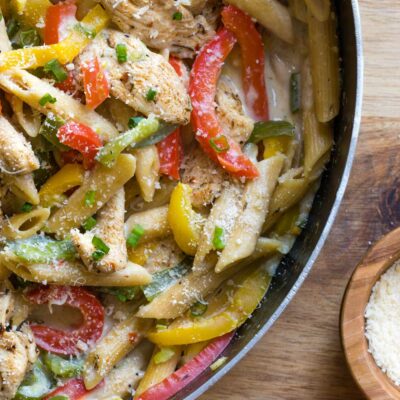
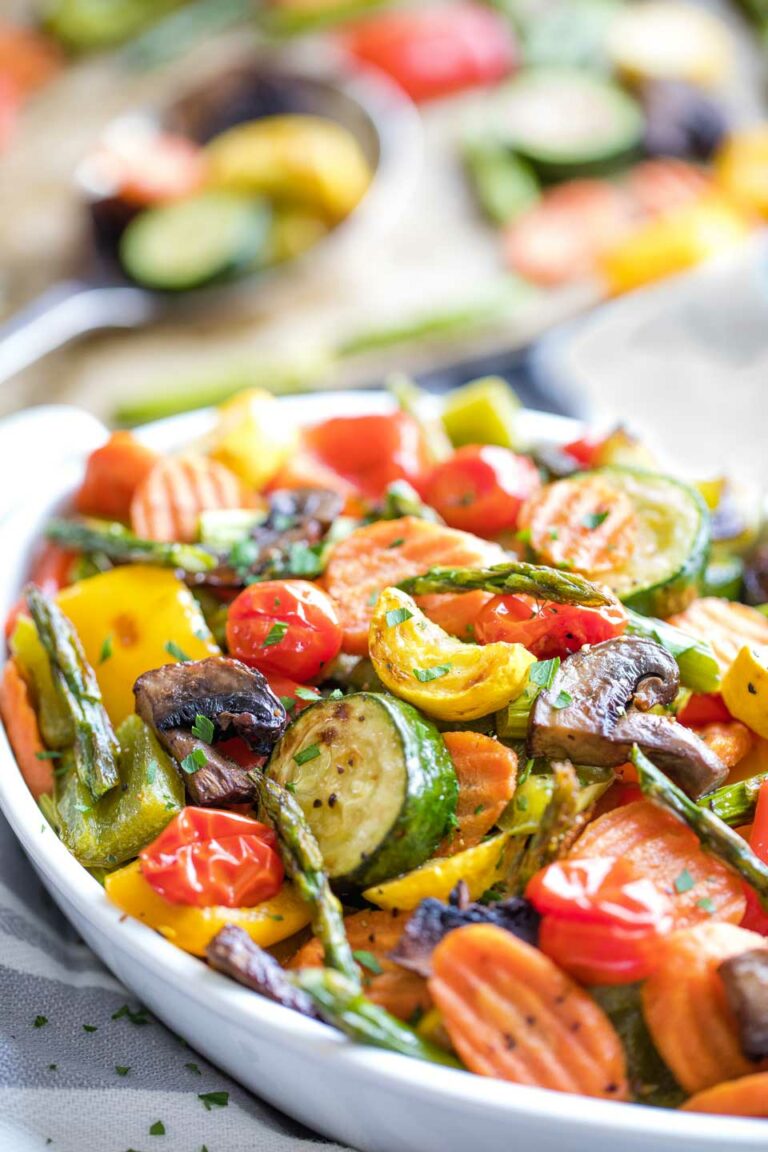
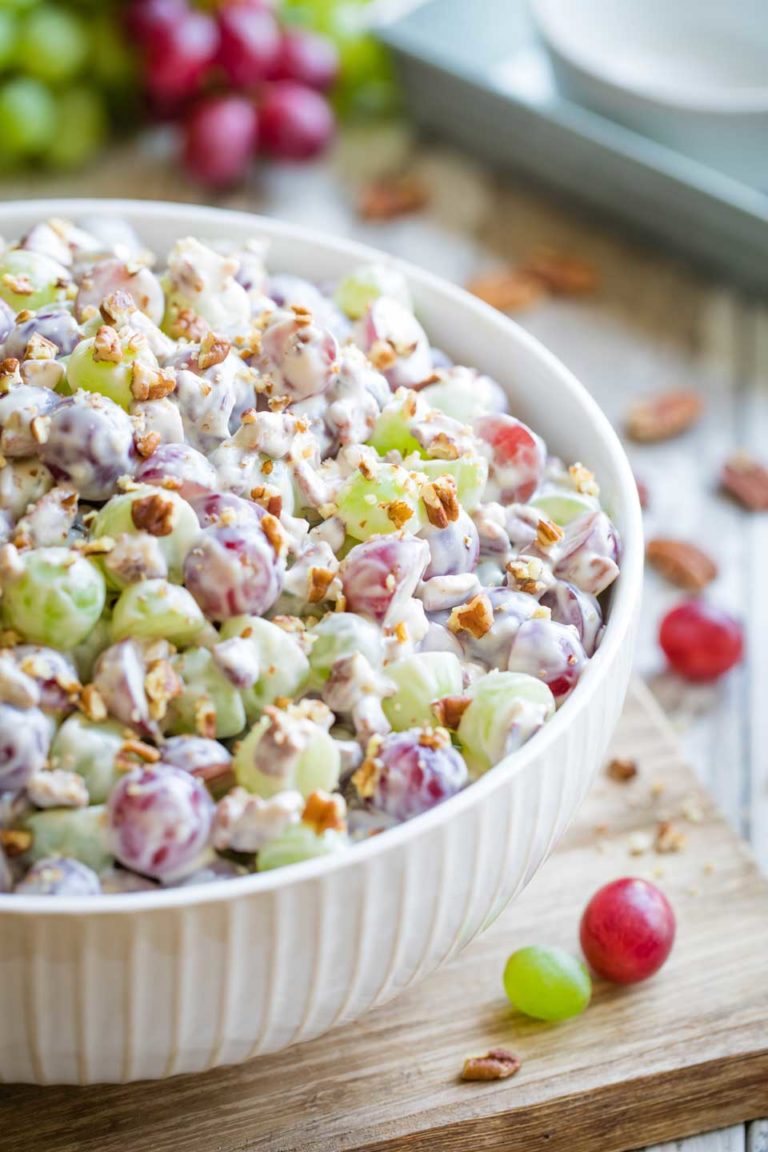
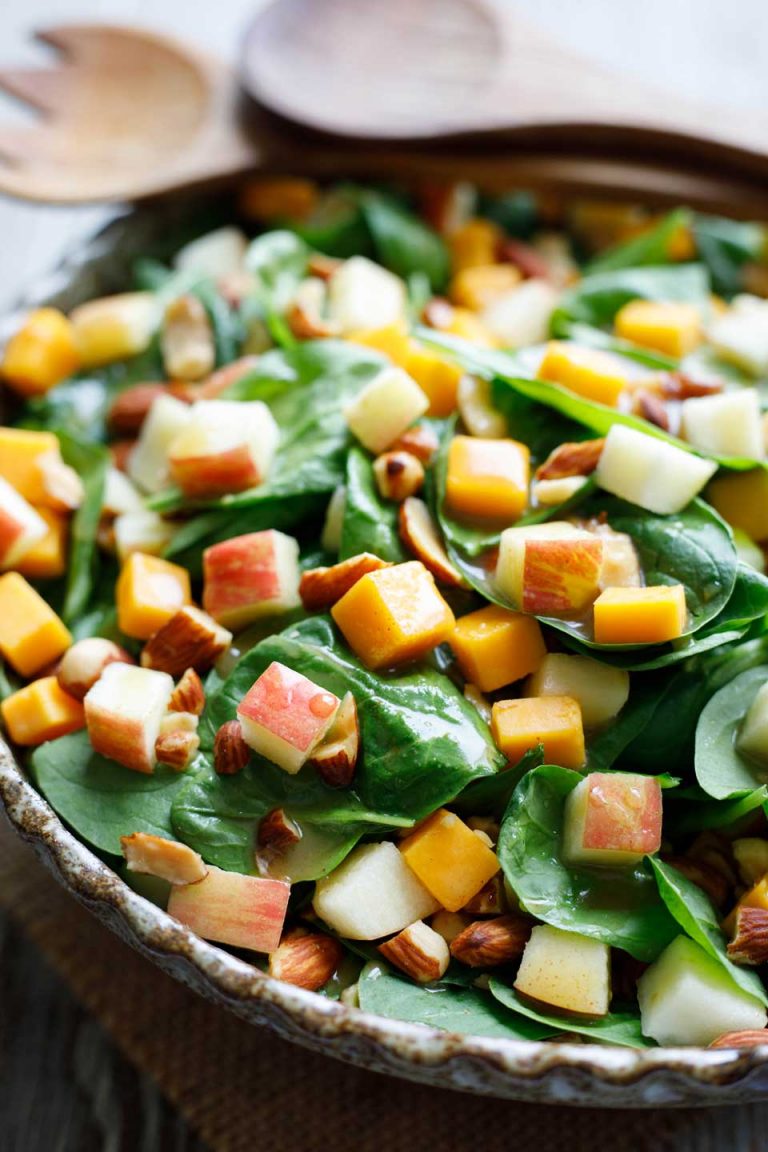
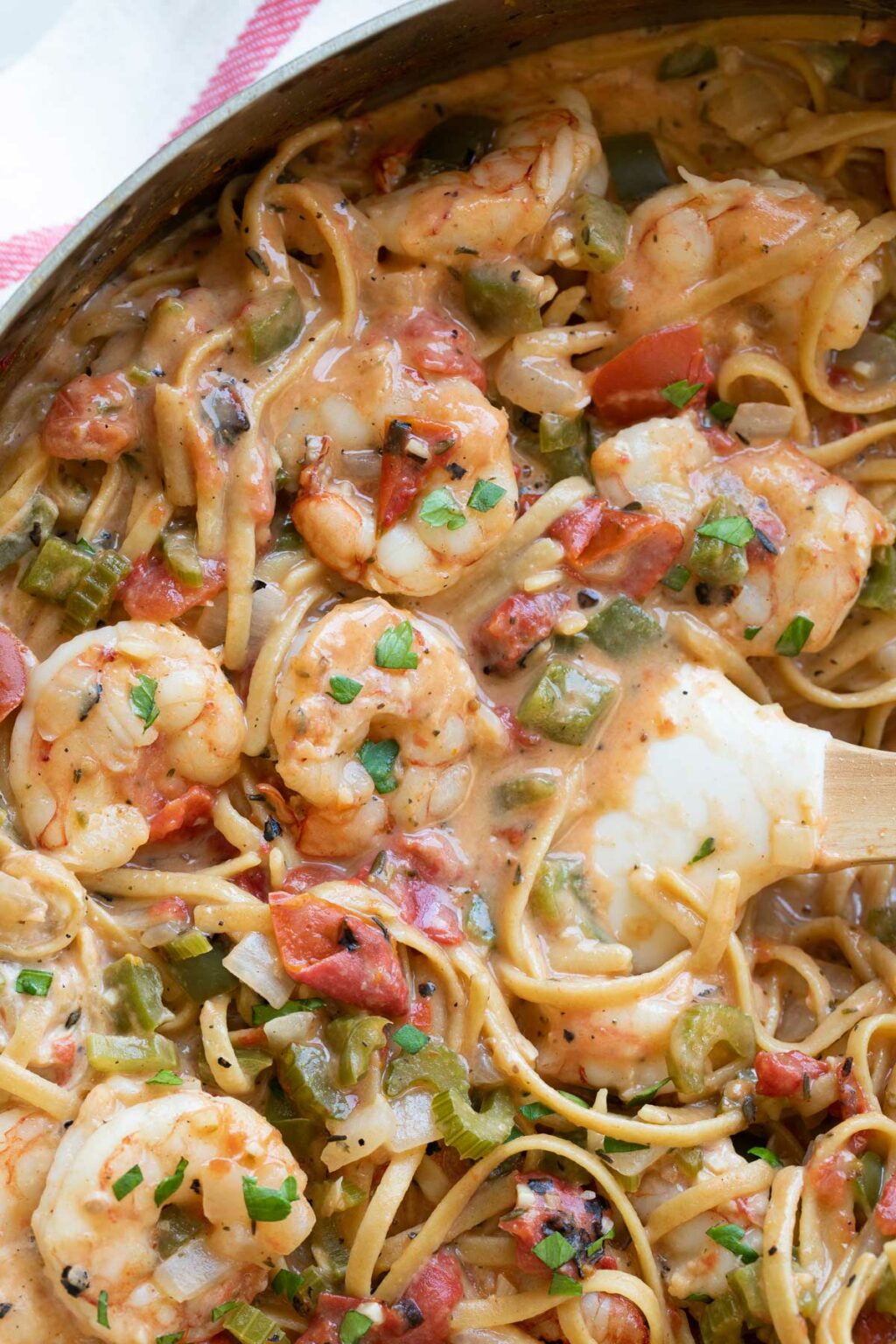
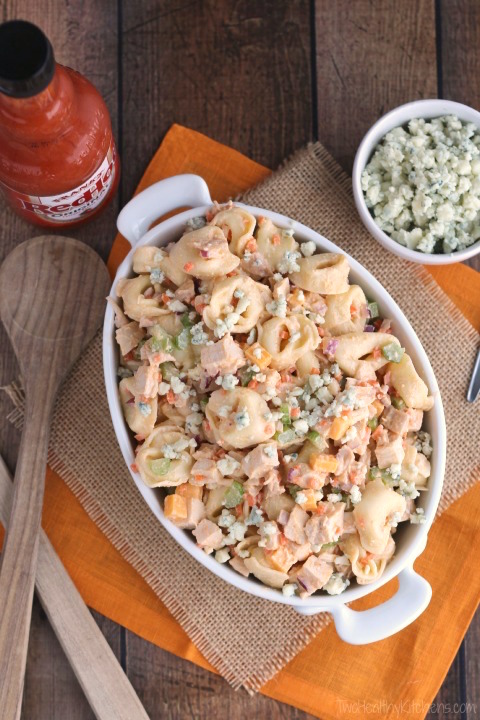
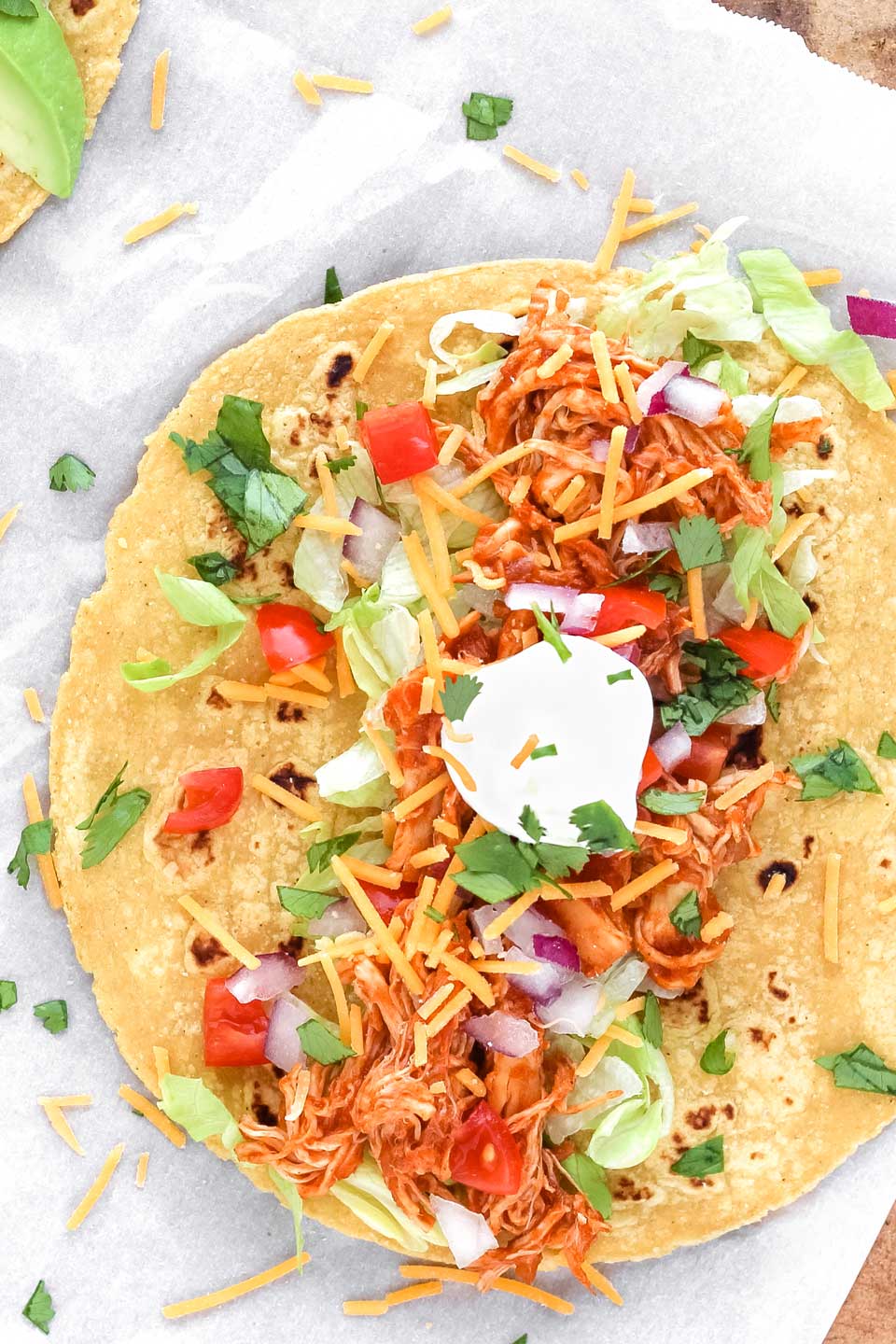
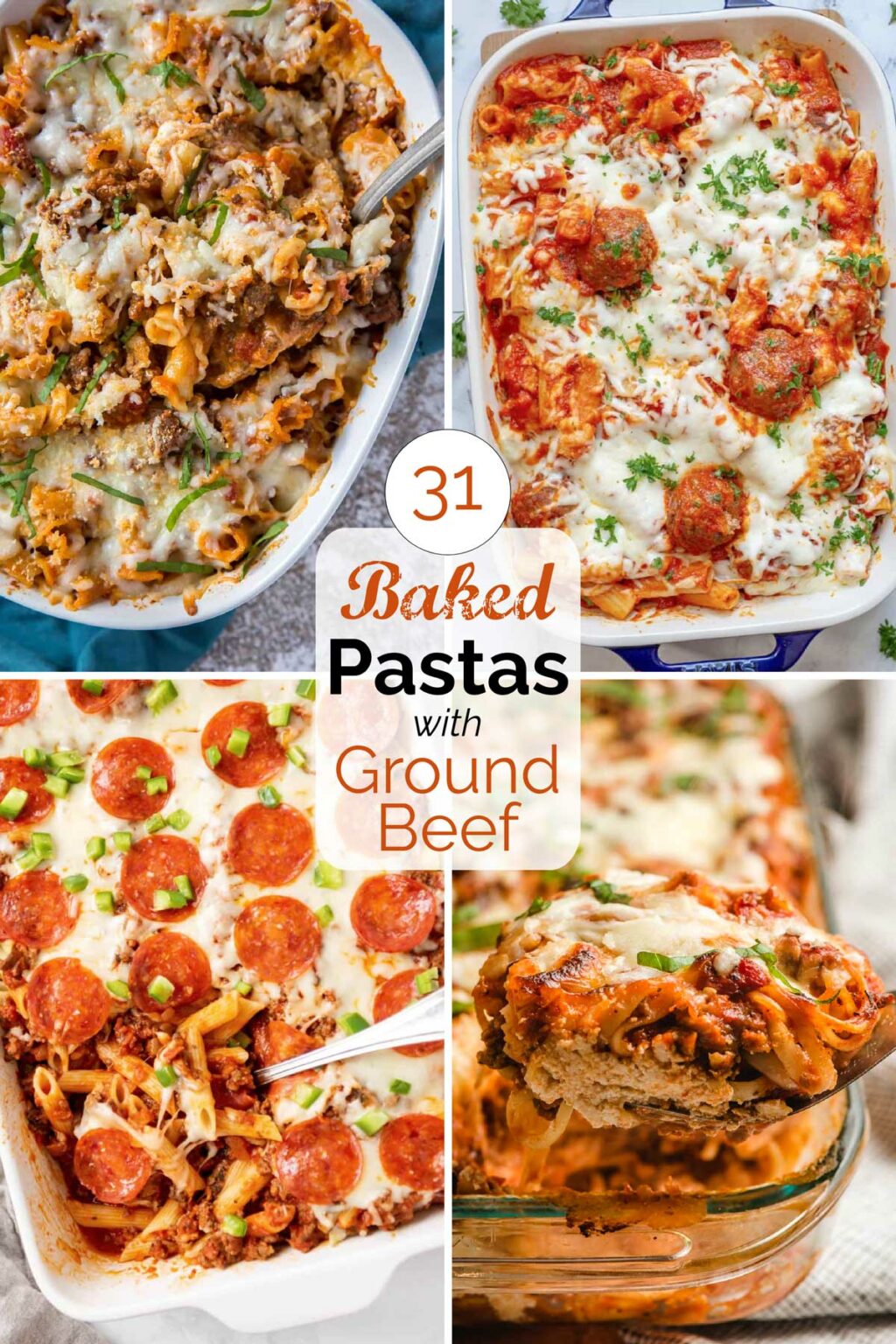
A friend of mine made this a few years ago when I was over for dinner and it was delicious. I forgot to ask for the recipe. I’m so happy to find it! Can’t wait to try it out.
Oh yay – I’m thrilled to have you try this, and so glad I could help you in your search for a beloved recipe! ~Shelley
Perfect! I love this recipe! I haven’t made something like this in ages. Thanks for the idea!
I’m so happy you love this, too, Suja! I’m always so tempted when I see Rasta Pasta offered at restaurants, but it’s usually just tooooo unhealthy. I wanted to make it at home – both healthier AND also EASY! So glad you like my version! ~Shelley
Fantastic flavors here! Never thought to incorporate jerk seasoning with pasta but here we are, and we are HERE for it.
Haha Dana – YES!! It really is so flavorful. Just that hint of spice (well, unless you add lots more jerk seasoning, of course!) that’s comforting and family-friendly, but still packs big-time Jamaican flavor. Crazy good – no wonder Rasta Pasta is on so many restaurant menus, right?!? (I bet you’ll start noticing it everywhere, now that you’re hooked!) Mmmmmm … ENJOY! ~Shelley
Colorful and delicious pasta recipe. Thanks for sharing.
Oh hi there – so great to hear from you! I’m really happy you thought this was delicious – I hope you’ll make it often! 😀 ~Shelley
Can it be frozen?
Hi, Shelley – that’s a good question. Although I frequently test recipes to see if they freeze well, I don’t normally do that with my pasta dishes. Cream-based sauces can be finicky about freezing, thawing and reheating. However, because the cream sauce in this Rasta Pasta isn’t a traditionally formulated alfredo sauce, my guess is that it will still be fine, as long as you reheat it gently (it does stay stable upon reheating when it’s been stored in the refrigerator). Again, though, I can’t say for sure, since I haven’t run it through that scenario in the test kitchen. If you give it a try, I’d love to know how it goes – good luck! (Love the name BTW!! 😀 ) ~Shelley